Featured on

- What is a visa?
- Electronic Visa (eVisa)
- Visa on Arrival
- Appointment Required Visa
- Invitation Letter
- Arrival Card
- Passport Renewal
- Project Kosmos: Meet the man with the world's most challenging travel schedule
- Australia Visa and ETA requirements for US citizens explained
- Brazil eVisa for US citizens
- India Tourist Visa for UK citizens
- Possible B1/B2 Visa questions during the interview

Select Your Language
- Nederlandse
- 中文 (Zhōngwén), 汉语, 漢語
Select Your Currency
- AED United Arab Emirates Dirham
- AFN Afghan Afghani
- ALL Albanian Lek
- AMD Armenian Dram
- ANG Netherlands Antillean Guilder
- AOA Angolan Kwanza
- ARS Argentine Peso
- AUD Australian Dollar
- AWG Aruban Florin
- AZN Azerbaijani Manat
- BAM Bosnia-Herzegovina Convertible Mark
- BBD Barbadian Dollar
- BDT Bangladeshi Taka
- BGN Bulgarian Lev
- BIF Burundian Franc
- BMD Bermudan Dollar
- BND Brunei Dollar
- BOB Bolivian Boliviano
- BRL Brazilian Real
- BSD Bahamian Dollar
- BWP Botswanan Pula
- BZD Belize Dollar
- CAD Canadian Dollar
- CDF Congolese Franc
- CHF Swiss Franc
- CLP Chilean Peso
- CNY Chinese Yuan
- COP Colombian Peso
- CRC Costa Rican Colón
- CVE Cape Verdean Escudo
- CZK Czech Republic Koruna
- DJF Djiboutian Franc
- DKK Danish Krone
- DOP Dominican Peso
- DZD Algerian Dinar
- EGP Egyptian Pound
- ETB Ethiopian Birr
- FJD Fijian Dollar
- FKP Falkland Islands Pound
- GBP British Pound Sterling
- GEL Georgian Lari
- GIP Gibraltar Pound
- GMD Gambian Dalasi
- GNF Guinean Franc
- GTQ Guatemalan Quetzal
- GYD Guyanaese Dollar
- HKD Hong Kong Dollar
- HNL Honduran Lempira
- HTG Haitian Gourde
- HUF Hungarian Forint
- IDR Indonesian Rupiah
- ILS Israeli New Sheqel
- INR Indian Rupee
- ISK Icelandic Króna
- JMD Jamaican Dollar
- JPY Japanese Yen
- KES Kenyan Shilling
- KGS Kyrgystani Som
- KHR Cambodian Riel
- KMF Comorian Franc
- KRW South Korean Won
- KYD Cayman Islands Dollar
- KZT Kazakhstani Tenge
- LAK Laotian Kip
- LBP Lebanese Pound
- LKR Sri Lankan Rupee
- LRD Liberian Dollar
- LSL Lesotho Loti
- MAD Moroccan Dirham
- MDL Moldovan Leu
- MGA Malagasy Ariary
- MKD Macedonian Denar
- MNT Mongolian Tugrik
- MOP Macanese Pataca
- MUR Mauritian Rupee
- MVR Maldivian Rufiyaa
- MWK Malawian Kwacha
- MXN Mexican Peso
- MYR Malaysian Ringgit
- MZN Mozambican Metical
- NAD Namibian Dollar
- NGN Nigerian Naira
- NIO Nicaraguan Córdoba
- NOK Norwegian Krone
- NPR Nepalese Rupee
- NZD New Zealand Dollar
- OMR Omani Rial
- PAB Panamanian Balboa
- PEN Peruvian Nuevo Sol
- PGK Papua New Guinean Kina
- PHP Philippine Peso
- PKR Pakistani Rupee
- PLN Polish Zloty
- PYG Paraguayan Guarani
- QAR Qatari Rial
- RON Romanian Leu
- RSD Serbian Dinar
- RUB Russian Ruble
- RWF Rwandan Franc
- SAR Saudi Riyal
- SBD Solomon Islands Dollar
- SCR Seychellois Rupee
- SEK Swedish Krona
- SGD Singapore Dollar
- SHP Saint Helena Pound
- SLL Sierra Leonean Leone
- SOS Somali Shilling
- SRD Surinamese Dollar
- SVC Salvadoran Colón
- SZL Swazi Lilangeni
- THB Thai Baht
- TJS Tajikistani Somoni
- TOP Tongan Pa anga
- TRY Turkish Lira
- TTD Trinidad and Tobago Dollar
- TWD New Taiwan Dollar
- TZS Tanzanian Shilling
- UAH Ukrainian Hryvnia
- UGX Ugandan Shilling
- USD United States Dollar
- UYU Uruguayan Peso
- UZS Uzbekistan Som
- VND Vietnamese Dong
- VUV Vanuatu Vatu
- WST Samoan Tala
- XAF CFA Franc BEAC
- XCD East Caribbean Dollar
- XOF CFA Franc BCEAO
- XPF CFP Franc
- YER Yemeni Rial
- ZAR South African Rand
- ZMW Zambian Kwacha
We've updated our app!
Download it now
Mexico Tourist Visa for Chinese Citizens: Apply for the Mexico Visa Now
Get ready to explore the vibrant culture and breathtaking landscapes of Mexico! From ancient ruins to sun-kissed beaches in Cancun and Puerto Vallarta, there's something for everyone to enjoy.
If you're a Chinese citizen planning a visit, it's important to know about the Mexican visa application process and Tourist Card requirements.
Our handy guide has got you covered with all the valuable insights you need for a smooth and unforgettable trip.
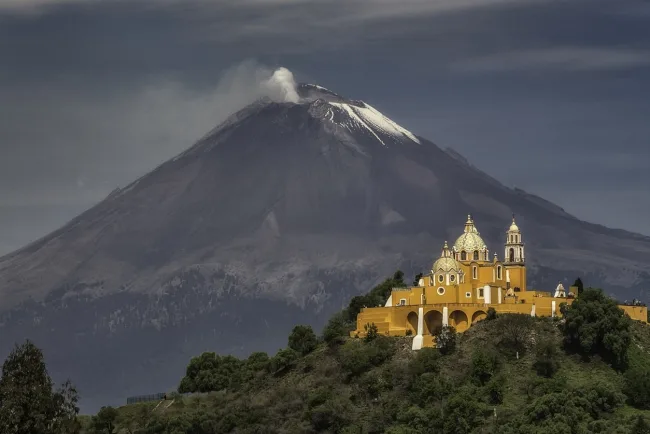
What is the Mexico Tourist Visa for citizens of China?
The Mexico Tourist Visa is a mandatory document for foreign nationals requiring a visa to enter Mexico. It allows them to engage in various activities during their stay, including:
Tourism : Explore Mexico's captivating landmarks, ancient ruins, and vibrant cities.
Business: Attend meetings, conferences or explore potential business opportunities.
Cultural or sports purposes: Immerse yourself in Mexico's rich cultural heritage or participate in sports events.
Explore Mexico: Discover the country's diverse landscapes, from beautiful beaches to lush jungles.
It's important to note that the Mexico Tourist Visa strictly prohibits engaging in paid work or earning money while in Mexico. This visa is solely intended for non-employment activities, ensuring compliance with Mexican immigration regulations.
How long is the Mexico visa for Chinese citizens valid?
The Mexican tourist visa lets you enter the country for up to 180 days after issued It's valid for six months from the date it's issued and must be used within 90 days. You can stay in Mexico for up to 180 days and enter multiple times as this is a Multiple Entry visa. But if you want to stay longer, you need to ask for an extension from the Mexican Immigration Service (INM).
Do Chinese citizens need a Visa for Mexico?
Yes! Chinese passport holders must obtain a visa for tourism when visiting Mexico. China is not among the Mexico visa exemptions. They must also get a Mexico Tourist Card before entering the country.
Feeling overwhelmed by the process? Don't fret! We're here to assist you every step of the way, making sure you obtain a valid visa seamlessly.
Mexico Tourist Card
The Mexican Tourist Card or FMM is an important document for travelers entering Mexico from other countries. This document is not a visa nor a replacement for a visa but a travel document that helps Mexican authorities track the number of visitors.
A Mexican tourist card is necessary for Chinese visitors planning to travel to Mexico. However, please note that the card is only valid for leisure, vacation, or recreational purposes and can't be used for seeking employment.
Luckily, like the visa, you can apply for your Mexico tourist card online with us or download our app to apply on the go and have a more user friendly experience.
Please note that you can get your Mexico Tourist Card when you get to immigration. However, if you’re traveling by land, you can apply for the Mexico Tourist Card-Land through iVisa beforehand.
Am I eligible for a Mexico Tourist Visa in China?
Chinese citizens who wish to apply for a Mexico Tourist Visa must fulfill the following eligibility requirements:
Hold a valid passport with a minimum validity of six months from the intended date of entry into Mexico.
Demonstrate sufficient financial means to cover the trip expenses and sustain themselves during their stay in Mexico.
Not be deemed inadmissible or prohibited from entering Mexico.
Complying with these eligibility requirements is vital for a Mexico Tourist Visa. We recommend thoroughly reviewing the eligibility criteria and visa requirements before submitting your application, ensuring a smooth and successful visa application process.
Apply for your visa in just a few clicks
Mexico Tourist Visa fee: Cost of the Visa for citizens of China
iVisa offers a standard processing fee of USD $147.99 and a government fee of USD $60.
In addition to our affordable price, you'll also enjoy the following benefits:
Our team of iVisa experts guarantees that your application will fully comply with government requirements.
Benefit from having unlimited access to a dedicated team of iVisa experts who will guide you through the entire application process, ensuring a smooth experience from start to finish.
With our simplified application form , you won’t have to deal with tedious questions on the official government website. We provide straightforward questions and handle all the necessary work for you.
With our service, you can complete the form at your own pace, make changes whenever needed, and save your progress for later continuation.
By choosing iVisa, you gain exclusive access to a detailed step-by-step manual. This comprehensive guide includes valuable tips for answering challenging questions, a complete list of required documents, and thorough guidance to help you obtain your valid visa.
To make your visa application experience even smoother, you can download our app and submit your request faster from your mobile device. Select our service to have a seamless and trouble-free visa application process.
Mexico Tourist Visa application: How to apply easily in China
Applying for your visa with us is a walk in the park. While you still need to gather your documents and visit the embassy, our guidance and assistance make the entire process incredibly straightforward.
Here's how it works:
Step one: Fill out the user-friendly online application form with accurate personal details such as your name, contact information, employment particulars, and financial information. It's crucial to ensure that the information aligns with your identification documents.
Step two: Once you've completed the application form, choose the processing time that suits your preferences and proceed with the payment using your credit or debit card. It's as easy as pie!
Step three: Stay alert to your inbox as we'll promptly email you a comprehensive guide. This guide will walk you through each step of the process, from gathering the necessary documents to understanding where and how to submit them. We'll even assist in scheduling an appointment at the embassy.
What is the Mexico Tourist Visa processing time in 2023 for Citizens of China?
We guarantee a 30 days processing time for the Mexico visa application. It's important to note that our processing time doesn’t include the government’s processing time, so we recommend that you apply at least 2 months in advance.
Necessary documents for the Mexico Tourist Visa for Citizens of China
Before applying for your visa, make sure you have the following ready:
A passport or other travel document that meets the requirements outlined below.
Passport-size photograph that meets the specifications outlined below.
A booked return travel ticket indicating when you plan to leave Mexico.
Proof of sufficient financial means to cover the duration of your stay, which may include bank statements from the past three months.
Proof of accommodation, such as a hotel booking or the name and address of a friend or family member you'll be staying with.
Documents about your employment status.
A credit or debit card to pay the visa application fee.
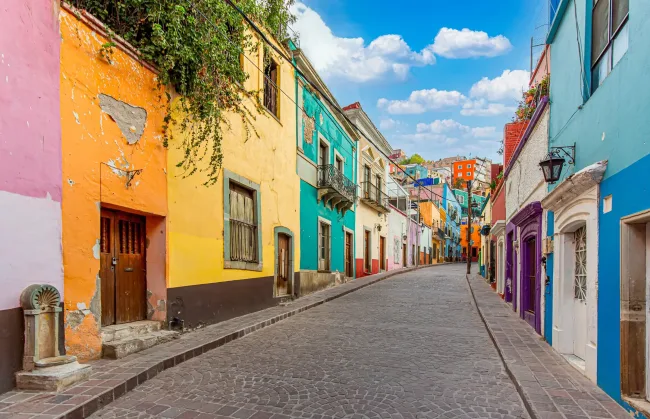
Mexico Tourist Visa passport requirements for citizens of China
To submit a Mexico visa application, your passport must meet the following conditions:
The passport must be valid for at least 6 months beyond your intended departure date from Mexico.
Your passport must have an available blank page for visa placement.
There should be no obvious damage to your passport.
The name on your passport must correspond with the name on your other identity documents.
Mexico Tourist Visa photo requirements for citizens of China
To apply for a Mexico visa, you must submit a passport-sized photograph meeting the following requirements:
The photograph must be in color and have a white background.
Your head should be facing straight toward the camera and should fill the entire frame.
Your eyes must be open and visible.
You should maintain a neutral facial expression with no smiling.
Don't wear glasses or headgear.
The photograph must be sized at 45 x 35mm.
Only one photograph is required for your visa application.
Mexico Tourist Visa requirements for minors
The application for minors must include the following:
A copy of the unabridged birth certificate.
Court documents (e.g. in adoption or shared custody cases)
Death certificate (if one of the minor's parents is deceased)
The child and both parents must appear in person for the appointment, or you must provide a police affidavit, confirming that the other parent has authorized you to apply for a visa and bring the child overseas.
What types of Mexican visas are available for Citizens of China?
Mexico Visitor Visa : Holders of this visa are permitted to remain in Mexico for a maximum duration of 180 days after issued (6 months). This visa is designed for individuals engaging in volunteer work, travel, or tourism purposes. It's important to note that the validity period of the Mexican visitor visa can't be extended.
Mexico Business Visa: Chinese nationals can use this visa to participate in various business activities, including trade exhibitions, seminars, conferences, and meetings.
Mexico Work Visa: Holders of this visa are eligible to work in Mexico if they have received a job offer or employment agreement from a Mexican-based business as a Chinese citizen.
Family Visa: To join a family member in Mexico as a foreign national, you must obtain a Mexico Family Visa, also called a Temporary or Permanent Resident Visa. If you intend to stay with your relatives in Mexico for more than 180 days, you must apply for this visa. However, if your visit is shorter than 180 days, a Mexico Tourist/Visitor Visa will suffice.
For these visas you can contact your local Mexican Embassy to find out more information on how to apply.
Remember to apply for the appropriate visa based on the duration of your stay to ensure a seamless and hassle-free entry into Mexico.
My Mexico Tourist Visa application was denied. What should I do?
Ensuring compliance with all requirements and providing accurate information is essential when applying for a Mexico visa.
In case of a visa application denial, please be aware that the Mexico visa process does not permit appeals. Consequently, if you wish to reapply, you must submit another application through our app or online. Our visa experts will help you every step of the way.
How to prepare for the Mexico Tourist Visa interview as a citizen of China?
Preparing for the Mexico Tourist Visa interview as a Chinese citizen requires careful attention to detail. Here are some essential tips to help you get ready:
Review your application: Familiarize yourself with the information you provided in your visa application. Ensure that all details are accurate and consistent.
Gather supporting documents: Collect all the required supporting documents, such as your valid passport, proof of financial stability, travel itinerary, accommodation details, and any other documents specified by the Mexican embassy or consulate.
Be knowledgeable: Stay informed about Mexico's tourist attractions, culture, and history. This will demonstrate your genuine interest in visiting the country.
Practice your interview: Prepare for possible interview questions, such as your purpose of visit, planned activities in Mexico, and your intent to return to China after your trip. Practice your answers to enhance your confidence during the interview.
Dress appropriately: Choose formal or business attire to create a professional impression. Dressing neatly and conservatively will show respect for the interview process.
Arrive early: Plan to arrive at the interview location ahead of time to avoid any unnecessary stress. Punctuality is valued and demonstrates your seriousness about the visa application.
Stay calm and confident: During the interview, maintain a calm and composed demeanor. Speak clearly, confidently, and truthfully in response to the interviewer's questions.
Remember, thorough preparation and a positive attitude can greatly increase your chances of a successful Mexico Tourist Visa interview.
Things to do in Mexico
Here are four interesting things to do in Mexico:
Visit the ancient Mayan ruins: Explore archaeological sites like Chichen Itza or Tulum to marvel at the impressive structures and learn about the fascinating Mayan civilization.
Discover Mexico City: Immerse yourself in the vibrant capital city, Mexico City. Explore historic landmarks, visit world-class museums like the National Museum of Anthropology, and indulge in delicious street food.
Relax in Riviera Maya: Unwind on the stunning beaches of Riviera Maya, where you can snorkel in crystal-clear waters, explore underwater caves (cenotes), or visit the ancient ruins of Tulum.
Explore the colonial charm of San Miguel de Allende: Wander through the picturesque streets of this enchanting colonial town, admire the colorful architecture, and visit art galleries and local markets.
You can find out more about how to prepare for your trip, what to eat and where to go in our complete Mexico guide .
Mexico is an exhilarating and captivating destination to explore. With its breathtaking coastlines, vibrant cities, and diverse wildlife, there's something to delight every traveler. Immerse yourself in the enchanting landscapes, catch the perfect wave at world-renowned surf spots, or encounter mesmerizing Mexican wildlife, including jaguars, toucans, and other iconic creatures. Whatever your interests may be, Mexico has it all. So start planning your dream getaway, and let us handle the visa application process for you. We're here to take care of all the necessary arrangements, allowing you to focus on creating unforgettable memories.
How to contact iVisa
If you have any questions about the application, don’t hesitate to contact our customer service team , who will be able to answer any questions you may have via online chat. You can also email us at [email protected] .
Related Articles
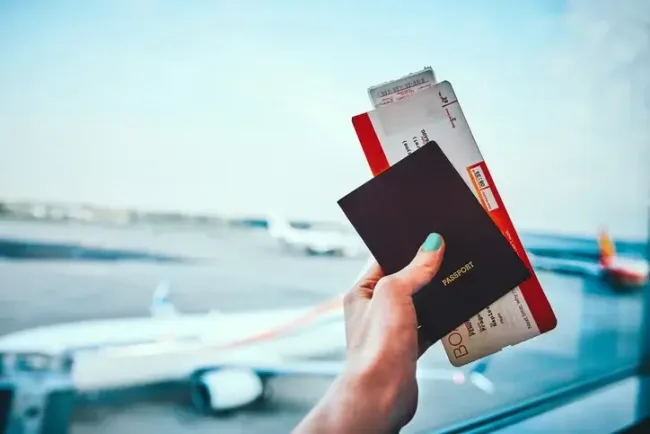
Mexican passport renewal: Everything you must know

Mexico Tourist Visa for Citizens of El Salvador: Apply for the Mexican Visa Now

Mexico Tourist Visa for Brazilian Citizens: Apply for the Mexican Visa Now
- iVisa is NOT affiliated with any government agency. This site does not provide legal advice and we are not a law firm. None of our customer service representatives are lawyers and they also do not provide legal advice. We are a private, internet-based travel and immigration consultancy provider dedicated to helping individuals travel around the world. You may apply by yourself directly on the various government websites. The source of information: https://embamex.sre.gob.mx/finlandia/index.php/traveling/visas
Mexico Entry Requirements
Entry requirements for Mexico vary depending on the traveler’s nationality. The vast majority of foreigners must obtain a visa before entering Mexico. Currently, only 69 countries enjoy visa-exempt status for Mexico.
Whether they need to get a visa or not all visitors entering Mexico by land must obtain and complete an FMM (Forma Migratoria Multiple, or Tourist Card) before they can enter.
Countries with Entry Requirements to Mexico
No matter the country that issued a traveler's passport, all those entering Mexico are required to submit an FMM .
All foreign nationals must be granted a Mexican visa before visiting the country unless they belong to one of the following categories:
- They hold a passport issued by one of the 69 countries enjoying visa-free travel to Mexico.
- They already have a valid visa for one of the Schengen countries, Canada, Japan, the United Kingdom, or the United States.
- They are permanent residents of one of the Schengen member states, Canada, Chile, Colombia, Japan, Peru, the United Kingdom, or the United States.
- They have a valid APEC Business Travel Card (APBTC) with the ‘Mex’ code on the back and come from Australia, Brunei, Chile, Hong Kong, Indonesia, Japan, South Korea, Malaysia, New Zealand, Papua New Guinea, Peru, the Philippines, Russia, Singapore, Taiwan, Thailand, Vietnam.
Not all foreigners are eligible to apply for the same visas using the same channels. For example, only citizens of Russia, Turkey, and Ukraine can apply for a Mexican visa online (SAE).
What Documents Are Needed for Entry to Mexico?
The type of documents that are required in order to obtain permission to enter Mexico varies. However, all travelers must complete the Mexico Tourist Card before they can enter Mexico .
Travelers who are not visa-exempt for Mexico also need to obtain a visa in advance of travel. Visa requirements vary on the type of permit one is applying for .
Essential documents for all visas include:
- A valid, eligible passport
- A visa application form completed in all of its parts as accurately as possible
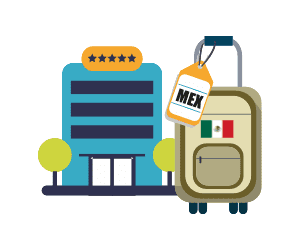
An electronic travel permit (officially called Sistema de Autorización Electrónica or SAE) is the easiest and quickest way to get permission to enter Mexico . To complete a SAE application, only the above documents are required and can be uploaded in digital format from anywhere in the world thanks to the online system.
Documents required for a Mexico entry permit: offline applications
Depending on the type of visa one is applying for, there are a variety of documents that a prospective visitor may need to submit. The reason for these document requirements is usually to prove the applicant’s plans, motivation to travel, financial capacity, and more.
Find below a list of supporting documentation covering several Mexican visas that can only be obtained offline.
Please note that it is a general list only, and that specific information should be obtained from a Mexican embassy or consulate before starting an application.
- Itinerary information including hotel reservations
- Travel plans such as a return plane ticket proving the applicant’s intention of remaining in Mexico only temporarily
- A recent, passport-sized photograph
- Financial information demonstrating the traveler’s ability to support themselves during their time in Mexico (this can be submitted in the form of cash, bank statements, credit cards, etc)
- Health information such as evidence of vaccinations and/ or medical insurance cover
- Invitation letter from a Mexican citizen or entity
- Official business letter stating the reason for the applicant’s travel
- Invitation letter from a Mexican institution to attend official events
- Invitation letter from an institution part of the National Education System stating the foreigner’s purposes and length of studies in Mexico
Foreign citizens should also note that while the electronic authorization can be paid for online via debit or credit card, most visas require the payment of an application fee in cash directly at the embassy.
Passport Requirements for Mexico
All foreign citizens must hold a valid and eligible passport if they wish to enter the Mexican territory. For all visitors, the passport must:
- Be valid for at least 6 months after the intended date of entry
- Contain blank pages to receive entry/exit stamps
Travelers crossing into Mexico by land are able to use either a valid passport book or passport card to enter the country.
Those who need a visa to enter Mexico must make sure that their passport data exactly matches the information provided in the visa application form .
Should the applicant’s passport fail to satisfy these criteria, the visa will be denied or canceled.
Please note that the passport provided during the application process and the granted visa are directly linked. Should the passport expire before the travel permit, both will become invalid and the traveler will have to apply again once a new passport is issued.
Foreign nationals will be asked to show their passport in several occasions including:
- When applying for the Mexico visa
- At the airport (travelers may be refused boarding if they fail to show their passport (and visa, if applicable) together with their plane ticket)
- At the immigration check at the Mexican border
- At checkpoints across the country
Although not all non-Mexican citizens need a visa, all foreigners must have a valid passport with them as they visit the country.
Which countries can Chinese passport holders visit without a visa?
- Medium Text

MUTUAL VISA EXEMPTION
Unilateral visa exception, visa on arrival, transit visa exemption.
Sign up here.
Reporting by Qiaoyi Li and Ryan Woo; Editing by Alison Williams
Our Standards: The Thomson Reuters Trust Principles. New Tab , opens new tab

World Chevron
The European Union criticised Russia on Saturday for putting subsidiaries of one Italian and one German company under the "temporary external management" of a Gazprom entity, saying the move underscored Moscow's disregard for international norms.

The Russian Defence Ministry said on Saturday that its forces had carried out 35 strikes in the last week against Ukrainian energy facilities, defence factories, railway infrastructure, air defences, and ammunition stocks.
skinny fit blazer mens for sale
Buy WES Formals Grey Slim-Fit Blazer from Westside
star trek 4k blu ray
Star Trek VIII: First Contact (4K Ultra HD Blu-ray Digital Copy), Paramount, Sci-Fi Fantasy

star citizen 60015
60 days hi-res stock photography and images Alamy

dji mavic pro uk finance
The Best Drone to Buy Now: DJI Mavic Pro

dell monitor brackets
VESA Mount Adapter for Dell S-Series Monitors S2440L, S2340L, S2340M, S2240L

bandsaws dremel
Dremel Shaper and Router Table
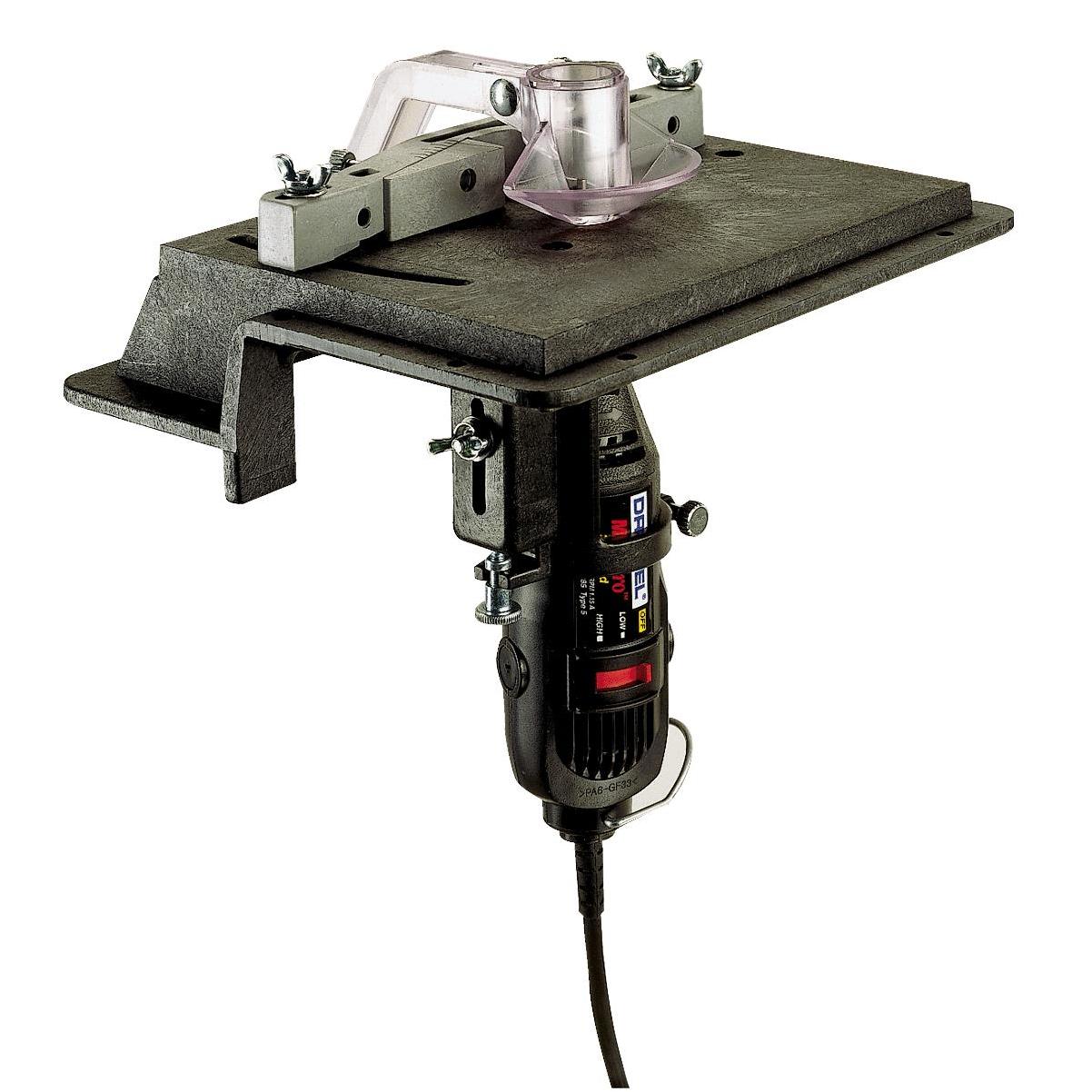
fast equipment
Chefmax Commercial OEM ODM Complete Restaurant|

what airport closest to amalfi coast
From Naples to Amalfi Coast to Rome: Days in Italy Itinerary Simply Lebanese

Lind jenny hi-res stock photography and images Page Alamy

canon pixma mg7753 colour ink-jet printer
Canon CLI571 ink cartridge yellow ORIGINAL

bobby brown ghostbusters soundtrack
On Our Own (From "Ghostbusters II" Soundtrack)

camper calling merchandise
Camper is calling Shirt I must go camping outdoor by Wwb

digitech vocal effects processor
DISC Digitech Vocalist Live Vocal Effects Processor at Gear4music

dyson vacuum roller not working
How To Clean the Brush Roll on ANY Vacuum FAST Remove Hair

1960s danelectro bronze standard
La Bella Electric Bass Guitar Danelectro 760FD La Bella 760FD LAB_760FD

asus f2a55-m
CT8715507 Crucial MX300 Series 2TB TLC SATA 6Gbps (AES-256) Internal Solid State Drive

touratech ambato exp
Der Touratech Tankrucksack Ambato Exp

fudge brownies without chocolate
DOUBLE CHOCOLATE FUDGE BROWNIES

squire by fender jazzmaster candy red
1966 Fender Jazzmaster Candy Apple Red Guitars Electric Solid Body TR Crandall Guitars

reviews for beldray 1200w hologen heater
Beldray Ceramic Heater 1500W of power ensures you get warmth as soon as you need ONLY ??£25 at #wilko #happypocketsuk #Christmas2022?? #costoflivingcrisisuk #ukenergyprices

see christian dior
Christian Dior Paris Ready to Wear Autumn Winter Flolength see through light blue dress short sleeves and silver embroidery Stock Photo Alamy

dkny horloge
DKNY Women's Soho D Stainless Steel Quartz Dress Watch

flower painters 20th century
Ilona Smith, floral 20th century flower Ilona Smith has a strong interest in botany and reimagined Stock Photo Alamy

esab origo mig l405
EQUIPO MIG ESAB ORIGO MIG L405, 220/440V

operacion condor español
Right-Wing Operation Condor Murderers Should Be in Jail

is ed hardy still in fashion
1,996 Ed Hardy Runway Stock Photos, High-Res Pictures, and Images Getty Images

assassins creed black flag console commands
ASSASSINS CREED ROGUE Cheats: Add Resources, No Reload, Godmode, Stealth, Trainer by PLITCH

durex invisivle
DUREX CONDOM INV EX-THIN LUB 8'S
suave in persian
Suave Persian Man

county of palm coast fl
PALM COAST UNCOVERED! The Best Palm Coast Florida Moving Guide

bulldog chain
Walbest Gold Chain Dog Collar Pitbull Collar Necklace Link Chain Collar for Small Medium Dog Puppy Jewelry Costume Accessories for Teddy French

https setup
Canon PIXMA TS6420a Wireless All-In-One Inkjet Printer, Eligible for PIXMA Print Plan Ink Subscription Service Dell USA

martial arts sword letters
Shaolin Double Broadsword 少林双刀:刀步相合 矫捷灵巧

suicideboys croc charms
Boy$ Charm – Alphabet

diamondback arden
Diamondback Arden used in 54 cm buycycle USA

denon x2300w pdf
Built an iOS app to control Denon Looking for feedback, please try out the beta

latast sammi louise berg porn
London, England, 8th Jan, General Secretary of Royal College of Nursing PAT CULLEN is seen outside BBC as she appears on Sunday With Laura (Credit Image: © Tayfun Salci/ZUMA

womens winter bogs
Women's Bogs Whiteout Adjustable Calf Winter Boots

technogym ball
Technogym Wellness Ball ACTIVE 3D Model for Download

fujitsu primergy tx100 s3 power supply
Original New PSU For Fujitsu TX100 S3 250W Power Supply S26113-E563-V50-01 DPS-250AB-62 A DPS-250AB-62A

Do you need a visa to go to Mexico?

Oct 24, 2023 • 4 min read

Find out if you can apply for a working holiday visa in Mexico © Thomas Barwick / Getty Images
Mexico is a vibrant country full of incredible culture and wonderful people – no wonder it's so continuously popular with visitors.
But navigating tourist permits, visas and officialdom can be daunting when you’re headed to a foreign country, especially one that revels in red tape. Have no fear! Here’s exactly what you need to know about entry requirements for Mexico .
Who doesn't need a visa for Mexico?
Citizens of the US, Canada, EU, Israel, Japan and dozens of other countries are among those who do not require a visa to enter Mexico as tourists.
The same goes for any visitor, regardless of nationality, who is a permanent resident of or has a valid visa from the US (including an H1-B visa), Canada, the United Kingdom and any country in the Schengen Area or Pacific Alliance.
Notwithstanding visas, all foreign visitors must have a passport with at least six months validity and a completed Forma Migratoria Múltiple (FMM), Mexico’s tourist card or stamp.
Where do I get an FMM?
The paper version of the FMM is gradually being phased out across Mexico and replaced with a passport stamp. However, when needed, FMM forms are available at border crossings , international airports and ports ; if you’re flying to Mexico, the form will be provided to you on-board your aircraft. The FMM form can also be completed online , printed and presented to immigration officials.
Processing an FMM costs US$28, which is paid on the spot at borders and ports or is integrated into the cost of airline tickets under “fees and surcharges.”
Upon entering Mexico, immigration officials stamp the FMM or your passport, adding the number of days you’re permitted to stay. Officials can approve up to 180 days but often grant less. Be sure to ask for the number of days you’ll need to cover your visit!
When you leave Mexico, you must surrender your FMM, if it’s a paper version. Keep it safe. If you lose it, you’ll face a US$40 fine.
The requirements are a little different if you're entering Mexico by land:
- FMMs are free for visitors staying less than seven days
- FMMs are not required for visitors who stay less than 72 hours in the " Zona Libre " or "Free Zone" – the areas 20 to 26 km (12 to 16 miles) south of the US border
- If you're entering through the Zona Libre but are planning to travel beyond its limits, request an FMM form when crossing the border. If you forget, you’ll be stopped upon return to the Zona Libre and made to pay for the FMM. If departing Mexico from beyond the Zona Libre , you may be fined if you don’t have an FMM.

Visitors requiring a visa
Chinese, Indian, Russian and South African citizens are among those who are required to have a tourist visa to enter Mexico . In addition to having a valid passport, the following must be submitted in person at the nearest Mexican embassy or consulate:
- Visa application form
- A color passport photograph
- Proof of ties to an origin country (eg, a letter certifying employment or full-time study)
- Proof of economic solvency (eg, three months of bank statements or investments)
- Approximately US$51 fee (cash or bank transfers only)
Appointments for tourist visas at Mexican embassies and consulates must be made online with the Secretaría de Relaciones Exteriores . At the pre-scheduled time, the submitted documents will be reviewed, biometric data taken (photo and fingerprints) and an interview conducted by a consular agent.
Once approved, a tourist visa is valid for up to 180 days. Upon entry to Mexico, travelers with tourist visas must also have an FMM.
Can I extend my stay in Mexico?
It's no surprise that many visitors wish to extend their visa and see more of Mexico. How you do that will depend on the details of your particular visit.
If your FMM was issued for less than 180 days, you can request an extension at an immigration office . Be sure to apply well before your FMM expires! Documents needed include a valid passport, valid FMM, valid tourist visa (if necessary) and proof of sufficient funds to remain in Mexico for the intended length of stay.
If your FMM was issued for 180 days, you'll need to leave Mexico and re-enter – this triggers the issuance of a new FMM. Most travelers opt to visit a neighboring country for just a couple of days before returning.
Travelers with tourist visas should seek an extension or apply for a new visa at an immigration office. Be sure to start the process well before the visa expires, as it may take some time to process the paperwork.

Can I take a working holiday in Mexico?
Mexico offers a working holiday visa called a " Visa Temporal – Vacaciones y Trabajo ," wherein certain foreign nationals are permitted to accept paid work in Mexico for up to 180 days. Those include citizens, aged 18 to 30, from Canada, Chile, Colombia, France, Germany, New Zealand, Peru and South Korea.
Extensions are not permitted and the visa cannot be converted into a work visa. To obtain this visa, schedule an appointment at your nearest Mexican embassy or consulate via the website of the Secretaría de Relaciones Exteriores .
This article was first published June 2021 and updated October 2023
Explore related stories

Apr 19, 2024 • 10 min read
Summer is just around the corner in the northern hemisphere. Here's where the Lonely Planet team is going.

Feb 19, 2024 • 7 min read

Feb 7, 2024 • 5 min read

Jan 27, 2024 • 15 min read

Dec 28, 2023 • 5 min read

Dec 27, 2023 • 8 min read

Dec 15, 2023 • 7 min read

Nov 5, 2023 • 11 min read

Oct 13, 2023 • 8 min read

Oct 10, 2023 • 9 min read


Do Chinese Citizens Need a Visa to Travel to Mexico?

Do you reside in China? Are you planning to visit Mexico? If the answer is yes, then this article is perfect for you.
Before you book the flight you could be wondering: Do Chinese citizens need a visa to enter Mexico? What visa do I need to travel to or visit Mexico? What are the visa requirements for Mexico? How long can I stay in Mexico on e-visa?
The majority of Chinese residents are asking these questions for themselves. As the world shrinks with modern technology and easier transportation options, it’s normal to desire to visit different parts of the globe.
But, if you’d like to travel to another country but don’t know the conditions for visas, then it could be a bit challenging.
Luckily, we’ll discuss visa requirements and other important information about traveling to Mexico with Chinese passport.
You should always plan ahead before traveling so that nothing goes wrong. To aid you in this, we have created this article, which provides useful information about what you need to know prior to your trip to Mexico.
We will discuss what type of visa you need to enter or visit Mexico, as well as how long you can stay in Mexico if your visa is approved.
This article will provide everything that you should be aware of when applying for a visa to visit Mexico as a citizen from China.
Read Also About: Mauritius
Read Also About: Mauritania
About Mexico
Mexico is one of the most beautiful nations in the world. It is renowned for its diverse culture and rich heritage. The country offers many possibilities for visitors to get to know its history and culture.
If you are looking for an ideal destination for your holiday or explore a new area, Mexico is an excellent choice!
One method to gain an understanding of what makes this country special is to go to one the many tourist destinations!
There are many things that make this country so unique. The first is that it has a rich and varied history that is evident in many towns and landmarks. In addition, it has a diverse population of people from across the globe living in the city.
If you’re thinking of visiting the area soon be sure to take a look at these tourist attractions to ensure that you do not miss out on anything!

Mexico is a country rich in culture, history and natural beauty. It is the perfect destination for anyone looking to travel. The best time to visit Mexico would be during the months of December through March when the weather is warm and dry with a little bit of rain or snowfall during winter months. Mexico is the most popular tourist destination in Central and South America. It is home to many world famous sites like the pyramids of Teotihuacan, Tulum and Chichen Itza. The Mayan ruins are stunning to see in person, as well as all of the other incredible archeological locations throughout Mexico. If you want to spend your days exploring and enjoying the best of the country, then Mexico is definitely the place for you. Mexico’s coastline extends across 11,000 km (6200 miles) and offers a fantastic array of beaches.
Read Also About: Marshall-Islands
Read Also About: Malta
Visa Requirements for Visiting Mexico With Chinese Passport:
In this article, we will talk about the requirement for visas for Mexico. However, prior to getting your eyes set on visiting Mexico it is important to know that there are many different types of visas and each has their own set of requirements.
If you’re contemplating a trip to Mexico There are a lot of factors to think about, such as the visa requirements for entering the country. Although no two countries will have identical procedures, each country has their own set of rules to get visas. These requirements will help you determine whether the excursion is worth the cost and effort.
If you are planning to visit an overseas country, the first thing you need to ensure that you have all the proper documentation to apply for a visa.
If you want to get a visa there are several documents that you will need like evidence of income or employment. The requirements will differ based on the type of visa you’re trying to apply for. So be sure to confirm before making any plans!
Visa is required to enter this country. You must apply for a visa before traveling to this country. There are various types of visas one can apply for, such as student visas, working visas, and touristic visas, which all fall into this category. Nevertheless, remember that every category has a distinguished variety of requirements. Some visas are hard to get, whereas others are granted very easily. The same is why one needs to conduct thorough research before selecting the type of Visa they wish to obtain. To acquire it, you must visit the embassy of the country you wish to travel to. You must submit all your legal documents and follow the guided procedure. Most of these visas are granted on a referral basis as well. However, it all depends upon the country. Please check with the embassy of the country for the requirements and the application process.
In conclusion, it is crucial to know the process by which Mexico visas operate and how they can impact how you travel. Although this article provides an outline of the process, you can also consult with your local consulate , or Embassy for more details about your specific situation.
Last Updated: 16/09/2022
Read Also About: Micronesia
Read Also About: Moldova
Read Also About: Monaco
Read Also About: Mongolia
Chinese Green Card Holders Can Now Travel to Mexico
Applying for a chinese green card, the benefits of a chinese green card, how to travel to mexico with a chinese green card, the requirements for a chinese green card, the process of applying for a chinese green card, the cost of a chinese green card, the time frame for a chinese green card, the validity of a chinese green card, the renewal process for a chinese green card, the advantages of having a chinese green card.
If you’re a Chinese national with a green card, you can now travel to Mexico without a visa. This is great news for anyone who wants to visit Mexico’s beautiful beaches and stunning archaeological sites.
Checkout this video:
Watch this video on YouTube
If you are a Chinese citizen and you want to visit Mexico, you will need to apply for a green card. The process is simple and can be done online. You will need to provide some personal information, as well as your passport number and a few other details. Once you have submitted your application, you will receive a confirmation email within 24 hours.
As a Chinese green card holder, you now have the ability to travel to Mexico without the need for a visa. This is a great benefit if you are planning on traveling to Mexico for business or pleasure. With a Chinese green card, you will also be able to enter Mexico with ease and convenience.
Chinese citizens who hold a green Card can now travel to Mexico without a visa, making it easier for them to visit family and friends or enjoy a vacation in this popular tourist destination.
The visa waiver program, which took effect on January 1, 2021, allows qualifying green card holders to stay in Mexico for up to 180 days. To be eligible, Chinese citizens must have a valid passport and green card as well as proof of sufficient funds for their stay in Mexico.
This new program is part of a larger effort by the Mexican government to improve relations with China and encourage more tourism and investment from Chinese citizens. In 2019, Mexico waivered visas for Chinese citizens holding business or tourist visas from the United States, Canada, Japan or any of the Schengen countries in Europe.
To be eligible for a Chinese Green Card, applicants must first have either a Mexican passport or a permanent residence visa. Applicants must also show proof of employment or investment in Mexico, as well as meet various other requirements such as having no criminal record and being in good health. Those who are granted a Chinese Green Card will be allowed to stay in Mexico for up to four years, and may eventually apply for Mexican citizenship.
Chinese citizens who wish to travel to Mexico for leisure or business purposes no longer need to apply for a visa in advance. Instead, they can now apply for a Chinese Green Card, which will allow them to stay in Mexico for up to 90 days.
The process of applying for a Chinese Green Card is relatively simple. First, Chinese citizens must fill out an online application form and submit it along with the required documents. Once the application is approved, they will receive a confirmation email with instructions on how to pay the application fee. After the fee is paid, applicants will receive their Chinese Green Card in the mail within 10-15 days.
The cost of a Chinese Green Card has been rising in recent years, making it more difficult for Chinese citizens to qualify for permanent residency in the United States. However, there is some good news for Chinese green card holders who wish to travel to Mexico.
Starting in July of 2020, the Mexican government will be issuing 10-year multiple-entry visas to Chinese nationals who hold valid U.S. green cards. This means that Chinese green card holders will no longer have to apply for a separate visa every time they want to travel to Mexico.
This is great news for Chinese green card holders who often travel back and forth between the United States and Mexico. With a 10-year multiple-entry visa, they will be able to stay in Mexico for extended periods of time without having to go through the hassle and expense of applying for a new visa every time they want to enter the country.
Chinese citizens who hold a green card can now travel to Mexico without a visa, the Mexican Embassy in Beijing has announced.
The announcement comes after the two countries agreed to waive visa requirements for holders of each other’s long-term residency permits.
Green card holders from China will be able to stay in Mexico for up to 180 days, while Mexican green card holders will be able to stay in China for up to 90 days.
As of January 1st, 2019, Mexican immigration authorities will now accept Chinese green cards as valid travel documents for Chinese citizens wishing to visit Mexico. This change comes as a result of a recent agreement between the Mexican and Chinese governments, and is part of an effort to improve travel relations between the two countries
Chinese green card holders will now be able to enjoy the same travel benefits as other foreign nationals with valid Mexican visas, including being able to stay in Mexico for up to 180 days per year. This is good news for Chinese citizens who wish to visit Mexico for leisure or business purposes, as it will make the process of obtaining a Mexican visa much easier.
Since 2013, China and Mexico have had a reciprocal agreement in place that allows holders of valid Chinese green cards to travel to Mexico for up to 180 days without a visa. In order to qualify for this benefit, Chinese green card holders must apply for a Mexican visa at a Mexican consulate or embassy prior to travel.
The process for renewing a Chinese green card is relatively simple and can be done online through the Mexican government’s website. Once the application is completed and submitted, the applicant will need to appear in person at a Mexican consulate or embassy to have their fingerprints taken and to submit any additional supporting documentation. After the visa is approved, the applicant will receive a sticker in their passport that is valid for up to 5 years.
While most Chinese citizens can only dream of traveling to Mexico, those with a Chinese Green Card now have the opportunity to explore this beautiful country. Thanks to a recent agreement between the two nations, holders of a Chinese Green Card are now eligible for a multiple-entry visa to Mexico.
This is great news for Chinese nationals who want to travel to Mexico for business or pleasure. Not only does it make the process of traveling to Mexico much easier, but it also opens up the possibility of visiting other countries in North and Central America.
There are many advantages to having a Chinese Green Card, but here are some of the most compelling reasons to consider applying for one:
1. You can travel freely to Mexico – and beyond. As a holder of a Chinese Green Card, you will no longer need to apply for a separate visa every time you want to visit Mexico. This makes travel much easier and more convenient.
2. You can stay in Mexico for longer periods of time. With a multiple-entry visa, you can stay in Mexico for up to 180 days at a time. This is ideal if you want to spend extended periods in the country, either for business or leisure.
3. You can work in Mexico. If you want to work while you’re in Mexico, having a Chinese Green Card will make it much easier to do so. While you will still need to obtain the proper work permit, having a Green Card will give you an advantage over other foreign nationals who don’t have one.
4. You can invest in Mexican businesses. If you’re looking for opportunities to invest in Mexican businesses, having a Green Card will give you preferential treatment over other foreign investors. This is because the Mexican government views Green Card holders as potential long-term residents and wants to encourage investment from this group.
5. You’ll enjoy better protection from the Mexican government. As a holder of a Chinese Green Card, you will be entitled to the same protections as Mexican citizens when it comes to things like crime and emergency situations
Related Posts

Which Countries Are on the Green List for Travel?

Can Someone With a Green Card Travel Outside the US?

The Best Army Green Travel Bags

The Traveler’s Notebook in Mint Green is a Must-Have
About the author.
Update April 12, 2024
Information for u.s. citizens in the middle east.
- Travel Advisories |
- Contact Us |
- MyTravelGov |
Find U.S. Embassies & Consulates
Travel.state.gov, congressional liaison, special issuance agency, u.s. passports, international travel, intercountry adoption, international parental child abduction, records and authentications, popular links, travel advisories, mytravelgov, stay connected, legal resources, legal information, info for u.s. law enforcement, replace or certify documents.
Before You Go
Learn About Your Destination
While Abroad
Emergencies
Share this page:
Travel Advisory August 22, 2023
Mexico - see state summaries.
Reissued after periodic review with general security updates, and the removal of obsolete COVID-19 page links.
Country Summary: Violent crime – such as homicide, kidnapping, carjacking, and robbery – is widespread and common in Mexico. The U.S. government has limited ability to provide emergency services to U.S. citizens in many areas of Mexico, as travel by U.S. government employees to certain areas is prohibited or restricted. In many states, local emergency services are limited outside the state capital or major cities.
U.S. citizens are advised to adhere to restrictions on U.S. government employee travel. State-specific restrictions are included in the individual state advisories below. U.S. government employees may not travel between cities after dark, may not hail taxis on the street, and must rely on dispatched vehicles, including app-based services like Uber, and regulated taxi stands. U.S. government employees should avoid traveling alone, especially in remote areas. U.S. government employees may not drive from the U.S.-Mexico border to or from the interior parts of Mexico, except daytime travel within Baja California and between Nogales and Hermosillo on Mexican Federal Highway 15D, and between Nuevo Laredo and Monterrey on Highway 85D.
Read the country information page for additional information on travel to Mexico.
Do Not Travel To:
- Colima state due to crime and kidnapping .
- Guerrero state due to crime .
- Michoacan state due to crime and kidnapping .
- Sinaloa state due to crime and kidnapping
- Tamaulipas state due to crime and kidnapping.
- Zacatecas state due to crime and kidnapping .
Reconsider Travel To:
- Baja California state due to crime and kidnapping .
- Chihuahua state due to crime and kidnapping .
- Durango state due to crime .
- Guanajuato state due to crime and kidnapping .
- Jalisco state due to crime and kidnapping .
- Morelos state due to crime .
- Sonora state due to crime and kidnapping .
Exercise Increased Caution When Traveling To:
- Aguascalientes state due to crime .
- Baja California Sur state due to crime .
- Chiapas state due to crime .
- Coahuila state due to crime .
- Hidalgo state due to crime .
- Mexico City due to crime .
- Mexico State due to crime .
- Nayarit state due to crime.
- Nuevo Leon state due to crime and kidnapping .
- Oaxaca state due to crime .
- Puebla state due to crime and kidnapping .
- Queretaro state due to crime .
- Quintana Roo state due to crime .
- San Luis Potosi state due to crime and kidnapping .
- Tabasco state due to crime .
- Tlaxcala state due to crime .
- Veracruz state due to crime .
Exercise Normal Precautions When Traveling To:
- Campeche state
- Yucatan state
Visit our website for Travel to High-Risk Areas .
If you decide to travel to Mexico:
- Keep traveling companions and family back home informed of your travel plans. If separating from your travel group, send a friend your GPS location. If taking a taxi alone, take a photo of the taxi number and/or license plate and text it to a friend.
- Use toll roads when possible and avoid driving alone or at night. In many states, police presence and emergency services are extremely limited outside the state capital or major cities.
- Exercise increased caution when visiting local bars, nightclubs, and casinos.
- Do not display signs of wealth, such as wearing expensive watches or jewelry.
- Be extra vigilant when visiting banks or ATMs.
- Enroll in the Smart Traveler Enrollment Program (STEP) to receive Alerts and make it easier to locate you in an emergency.
- Follow the Department of State on Facebook and Twitter .
- Follow the U.S. Embassy on Facebook and Twitter .
- Review the Country Security Report for Mexico.
- Mariners planning travel to Mexico should check for U.S. maritime advisories and alerts , which include instructions on reporting suspicious activities and attacks to Mexican naval authorities.
- Prepare a contingency plan for emergency situations. Review the Traveler’s Checklist .
- Visit the CDC page for the latest travel health information related to your travel.
Aguascalientes state – Exercise Increased Caution
Exercise increased caution due to crime.
Criminal activity and violence may occur throughout the state.
There are no restrictions on travel for U.S. government employees in Aguascalientes state.
Baja California state – Reconsider Travel
Reconsider travel due to crime and kidnapping.
Transnational criminal organizations compete in the border area to establish narco-trafficking and human smuggling routes. Violent crime and gang activity are common. Travelers should remain on main highways and avoid remote locations. Of particular concern is the high number of homicides in the non-tourist areas of Tijuana. Most homicides appeared to be targeted; however, criminal organization assassinations and territorial disputes can result in bystanders being injured or killed. U.S. citizens and LPRs have been victims of kidnapping.
U.S. government employees must adhere to the noted restrictions:
- Mexicali Valley: U.S. government employees should avoid the Mexicali Valley due to the heightened possibility of violence between rival cartel factions. The boundaries of the restricted area are: to the east, the Baja California/Arizona and Baja California/Sonora borders; to the south, from La Ventana (on Highway 5) due east to the Colorado River; to the west, Highway 5; and to the north, Boulevard Lazaro Cardenas/Highway 92/Highway 1 to Carretera Aeropuerto, from the intersection of Highway 1 and Carretera Aeropuerto due north to the Baja California/California border, and from that point eastward along the Baja California/California border.
- Travelers may use Highways 2 and 2D to transit between Mexicali, Los Algodones, and San Luis Rio Colorado during daylight hours. Travelers may also use Highways 1 and 8 to transit to and from the Mexicali Airport during daylight hours. Travel on Highway 5 is permissible during daylight hours.
There are no other travel restrictions for U.S. government employees in Baja California state. These include high-traffic tourism areas of border and coastal communities, such as Tijuana , Ensenada , and Rosarito .
Baja California Sur state – Exercise Increased Caution
There are no restrictions on travel for U.S. government employees in Baja California Sur state.
Campeche state – Exercise Normal Precautions
Exercise normal precautions.
There are no restrictions on travel for U.S. government employees in Campeche state.
Chiapas state – Exercise Increased Caution
There are no restrictions on travel for U.S. government employees in Chiapas state.
Chihuahua state – Reconsider Travel
Violent crime and gang activity are common. Most homicides are targeted assassinations against members of criminal organizations. Battles for territory between criminal groups have resulted in violent crime in areas frequented by U.S. citizens and U.S. government employees, including restaurants and malls during daylight hours. Bystanders have been injured or killed in shooting incidents. U.S. citizens and LPRs have been victims of kidnapping.
U.S. government employee travel is limited to the following areas with the noted restrictions:
- Ciudad Juarez: U.S. government employees may travel to the area of Ciudad Juarez bounded to the east by Bulevar Independencia; to the south by De los Montes Urales/Avenida Manuel J Clouthier/Carretera de Juárez; to the west by Via Juan Gabriel/Avenida de los Insurgentes/Calle Miguel Ahumada/Francisco Javier Mina/Melchor Ocampo; and to the north by the U.S.-Mexico border. Direct travel to the Ciudad Juarez airport (officially called the Abraham González International Airport) and the factories located along Bulevar Independencia and Las Torres is permitted. Travel to San Jerónimo is permitted only through the United States via the Santa Teresa U.S. Port of Entry; travel via Anapra is prohibited.
U.S. government employees may only travel from Ciudad Juarez to the city of Chihuahua during daylight hours via Federal Highway 45, with stops permitted only at the Guardia Nacional División Caminos station, the Umbral del Milenio overlook area, the border inspection station at KM 35, and the shops and restaurants on Federal Highway 45 in the city of Ahumada.
- U.S. government employees may travel between Ciudad Juarez and Ascension via Highway 2.
- Nuevo Casas Grandes Area (including Nuevo Casas Grandes, Casas Grandes, Mata Ortiz, Colonia Juárez, Colonia LeBaron, Paquimé and San Buenaventura): U.S. government employees may travel to the Nuevo Casas Grandes area during daylight hours via Mexico Federal Highway 2, and subsequently Federal Highway 10, to Nuevo Casas Grandes. Employees are permitted to stay overnight in the cities of Nuevo Casas Grandes and Casas Grandes only.
- City of Chihuahua: U.S. government employees may travel at any time to the area of the city of Chihuahua bounded to the north by Avenida Transformación; to the east by Avenida Tecnológico/Manuel Gómez Morín/Highway 16/Blvd.José Fuentes Mares; to the west by the city boundary; and to the south by Periférico Francisco R. Almada.
- U.S. government employees may travel on Highways 45, 16, and 45D through the city of Chihuahua and to the Chihuahua airport (officially called the General Roberto Fierro Villalobos International Airport).
- U.S. government employees may travel to Santa Eulalia to the east of the city of Chihuahua, as well as to Juan Aldama via Highway 16 to the northeast.
- U.S. government employees may travel south of the city of Chihuahua on Highway 45 to the southern boundary of Parral, including each town directly connected to Highway 45, including Lázaro Cárdenas, Pedro Meoqui, Santa Cruz de Rosales, Delicias, Camargo, Ciudad Jiménez, and Parral itself.
- U.S. government employees may only travel on official business from the city of Chihuahua on Highway 16 to Ciudad Cuauhtémoc bounded by Highway 21 to the north and east, Highway 5 to the west, and Bulevar Jorge Castillo Cabrera to the south.
- Ojinaga: U.S. government employees must travel to Ojinaga via U.S. Highway 67 and enter through the U.S. Port of Entry in Presidio, Texas.
- Palomas: U.S. government employees may travel to Palomas via U.S. highways through the U.S. Port of Entry in Columbus, New Mexico, or via Highway 2 in Mexico.
U.S. government employees may not travel to other areas of Chihuahua, including Copper Canyon .
Coahuila state – Exercise Increased Caution
Violent crime and gang activity occur in parts of Coahuila state.
U.S. government employees must adhere to the following travel restrictions:
- Zaragoza, Morelos, Allende, Nava, Jimenez, Villa Union, Guerrero, and Hidalgo municipalities : U.S. government employees may not travel to these municipalities.
- Piedras Negras and Ciudad Acuña: U.S. government employees must travel directly from the United States and observe a curfew from midnight to 6:00 a.m. in both cities.
There are no other restrictions on travel for U.S. government employees in Coahuila state.
Colima state – Do Not Travel
Do not travel due to crime and kidnapping.
Violent crime and gang activity are widespread. Most homicides are targeted assassinations against members of criminal organizations. Shooting incidents between criminal groups have injured or killed bystanders. U.S. citizens and LPRs have been victims of kidnapping.
Travel for U.S. government employees is limited to the following areas with noted restrictions:
- Manzanillo: U.S. government employee travel is limited to the tourist and port areas of Manzanillo.
- Employees traveling to Manzanillo from Guadalajara must use Federal Toll Road 54D during daylight hours.
U.S. government employees may not travel to other areas of Colima state.
Durango state – Reconsider Travel
Reconsider travel due to crime.
Violent crime and gang activity are common in parts of Durango state.
- West and south of Federal Highway 45: U.S. government employees may not travel to this region of Durango state.
There are no other restrictions on travel for U.S. government employees in Durango state.
Guanajuato state – Reconsider Travel
Gang violence, often associated with the theft of petroleum and natural gas from the state oil company and other suppliers, occurs in Guanajuato, primarily in the south and central areas of the state. Of particular concern is the high number of murders in the southern region of the state associated with cartel-related violence. U.S. citizens and LPRs have been victims of kidnapping.
- Areas south of Federal Highway 45D: U.S. government employees may not travel to the area south of and including Federal Highway 45D, Celaya, Salamanca, and Irapuato.
There are no other restrictions on travel for U.S. government employees in Guanajuato state, which includes tourist areas in: San Miguel de Allende , Guanajuato City , and surrounding areas.
Guerrero state – Do Not Travel
Do not travel due to crime.
Crime and violence are widespread. Armed groups operate independently of the government in many areas of Guerrero. Members of these groups frequently maintain roadblocks and may use violence towards travelers. U.S. citizens and LPRs have been victims of kidnapping in previous years.
Travel for U.S. government employees is limited to the following area with the noted restrictions:
- Taxco: U.S. government employees must use Federal Highway 95D, which passes through Cuernavaca, Morelos, and stay within downtown tourist areas of Taxco. Employees may visit Grutas de Cacahuamilpa National Park during the day with a licensed tour operator.
U.S. government employees may not travel to other areas of the state of Guerrero, including to tourist areas in Acapulco , Zihuatanejo , and Ixtapa .
Hidalgo state – Exercise Increased Caution
There are no restrictions on travel for U.S. government employees in Hidalgo state.
Jalisco state – Reconsider Travel
Violent crime and gang activity are common in parts of Jalisco state. In Guadalajara, territorial battles between criminal groups take place in tourist areas. Shooting incidents between criminal groups have injured or killed innocent bystanders. U.S. citizens and LPRs have been victims of kidnapping.
- Jalisco-Michoacan border and Federal Highway 110: U.S. government employees may not travel to the area between Federal Highway 110 and the Jalisco-Michoacan border, nor travel on Federal Highway 110 between Tuxpan, Jalisco, and the Michoacan border.
- Federal Highway 80: U.S. government employees may not travel on Federal Highway 80 south of Cocula.
There are no other restrictions on travel for U.S government employees in Jalisco state which includes tourist areas in: Guadalajara Metropolitan Area , Puerto Vallarta (including neighboring Riviera Nayarit) , Chapala , and Ajijic .
Mexico City (Ciudad de Mexico) – Exercise Increased Caution
Both violent and non-violent crime occur throughout Mexico City. Use additional caution, particularly at night, outside of the frequented tourist areas where police and security patrol more routinely. Petty crime occurs frequently in both tourist and non-tourist areas.
There are no restrictions on travel for U.S. government employees in Mexico City.
Mexico State (Estado de Mexico) – Exercise Increased Caution
Both violent and non-violent crime occur throughout Mexico State. Use additional caution in areas outside of the frequented tourist areas, although petty crime occurs frequently in tourist areas as well.
There are no restrictions on travel for U.S. government employees in Mexico State.
Michoacan state – Do Not Travel
Do not travel due to crime and kidnapping.
Crime and violence are widespread in Michoacan state. U.S. citizens and LPRs have been victims of kidnapping.
Travel for U.S. government employees is limited to the following areas with the noted restrictions:
- Federal Highway 15D: U.S. government employees may travel on Federal Highway 15D to transit the state between Mexico City and Guadalajara.
- Morelia: U.S. government employees may travel by air and by land using Federal Highways 43 or 48D from Federal Highway 15D.
- Lazaro Cardenas: U.S. government employees must travel by air only and limit activities to the city center or port areas.
U.S. government employees may not travel to other areas of the state of Michoacan, including the portions of the Monarch Butterfly Reserve located in Michoacan.
Morelos state – Reconsider Travel
Violent crime and gang activity are common in parts of Morelos state.
There are no restrictions on travel for U.S. government employees in Morelos state.
Nayarit state – Exercise Increased Caution
Criminal activity and violence may occur throughout Nayarit state.
There are no restrictions on travel for U.S government employees in Nayarit state.
Nuevo Leon state – Exercise Increased Caution
Exercise increased caution due to crime and kidnapping.
Criminal activity and violence may occur throughout the state. U.S. citizens and LPRs have been victims of kidnapping.
There are no restrictions on travel for U.S. government employees in Nuevo Leon state.
Oaxaca state – Exercise Increased Caution
Criminal activity and violence occur throughout the state.
U.S. travelers are reminded that U.S. government employees must adhere to the following travel restrictions:
- Isthmus region: U.S. government employees may not travel to the area of Oaxaca bounded by Federal Highway 185D to the west, Federal Highway 190 to the north, and the Oaxaca-Chiapas border to the east. This includes the cities of Juchitan de Zaragoza, Salina Cruz, and San Blas Atempa.
- Federal Highway 200 northwest of Pinotepa: U.S. government employees may not use Federal Highway 200 between Pinotepa and the Oaxaca-Guerrero border.
There are no restrictions on travel for U.S. government employees to other parts of Oaxaca state, which include tourist areas in: Oaxaca City , Monte Alban , Puerto Escondido, and Huatulco .
Puebla state – Exercise Increased Caution
There are no restrictions on travel for U.S. government employees in Puebla state.
Queretaro state – Exercise Increased Caution
There are no restrictions on travel for U.S. government employees in Queretaro state.
Quintana Roo state – Exercise Increased Caution
Criminal activity and violence may occur in any location, at any time, including in popular tourist destinations. Travelers should maintain a high level of situational awareness, avoid areas where illicit activities occur, and promptly depart from potentially dangerous situations.
While not directed at tourists, shootings between rival gangs have injured innocent bystanders. Additionally, U.S. citizens have been the victims of both non-violent and violent crimes in tourist and non-tourist areas.
There are no restrictions on travel for U.S. government employees in Quintana Roo state. However, personnel are advised to exercise increased situational awareness after dark in downtown areas of Cancun, Tulum, and Playa del Carmen, and to remain in well-lit pedestrian streets and tourist zones.
San Luis Potosi state – Exercise Increased Caution
Criminal activity and violence may occur throughout the state. U.S. citizens and LPRs have been victims of kidnapping.
There are no restrictions on travel for U.S. government employees in San Luis Potosi state.
Sinaloa state – Do Not Travel
Violent crime is widespread. Criminal organizations are based in and operating in Sinaloa. U.S. citizens and LPRs have been victims of kidnapping.
- Mazatlan: U.S. government employees may travel to Mazatlan by air or sea only, are limited to the Zona Dorada and historic town center, and must travel via direct routes between these destinations and the airport and sea terminal.
- Los Mochis and Topolobampo: U.S. government employees may travel to Los Mochis and Topolobampo by air or sea only, are restricted to the city and the port, and must travel via direct routes between these destinations and the airport.
U.S. government employees may not travel to other areas of Sinaloa state.
Sonora state – Reconsider Travel
Sonora is a key location used by the international drug trade and human trafficking networks. Violent crime is widespread. U.S. citizens and LPRs have been victims of kidnapping. Travelers should maintain a heightened level of awareness of their surroundings in all their travels in Sonora. Security incidents may occur in any area of Sonora.
- Travel between Hermosillo and Nogales: U.S. government employees may travel between the U.S. Ports of Entry in Nogales and Hermosillo during daylight hours via Federal Highway 15 only. U.S. government employees may not use ANY taxi services, public buses, nor ride-share applications due to a lack of secure vetting and/or dispatching procedures. Travelers should exercise caution and avoid unnecessary stops as security incidents, including sporadic, armed carjackings, and shootings have been reported along this highway during daylight hours. Travelers should have a full tank of gas and inform friends or family members of their planned travel.
- Nogales: U.S. government employees may not travel in the triangular area north of Avenida Tecnologico, west of Bulevar Luis Donaldo Colosio (Periferico), nor east of Federal Highway 15D (Corredor Fiscal). U.S. government employees also may not travel in the residential and business areas to east of the railroad tracks along Plutarco Elias Calle (HWY 15) and Calle Ruiz Cortino, including the business area around the Morley pedestrian gate port-of-entry. U.S. government employees may not use ANY taxi services, public buses, nor ride-share applications in Nogales due to a lack of secure vetting and/or dispatching procedures and the danger of kidnapping and other violent crimes.
- Puerto Peñasco: U.S. government employees may travel between Puerto Peñasco and the Lukeville-Sonoyta U.S. Port of Entry during daylight hours via Federal Highway 8 only. They may not travel on any other route to Puerto Peñasco. U.S. government employees may not use ANY taxi services, public buses, nor ride-share applications in Puerto Peñasco. due to a lack of secure vetting and/or dispatching procedures and the danger of kidnapping and other violent crimes.
- Triangular region near Mariposa U.S. Port of Entry: U.S. government employees may not travel into or through the triangular region west of the Mariposa U.S. Port of Entry, east of Sonoyta, and north of Altar municipality.
- San Luis Rio Colorado, Cananea, and Agua Prieta : U.S. government employees may travel directly from the nearest U.S. Port of Entry to San Luis Rio Colorado, Cananea (via Douglas Port of Entry), and Agua Prieta, but may not go beyond the city limits. Travel is limited to daylight hours only. Travel between Nogales and Cananea via Imuris is not permitted. U.S. government employees may not use ANY taxi services, public buses, nor ride-share applications in these cities due to a lack of secure vetting and/or dispatching procedures and the danger of kidnapping and other violent crimes.
- Eastern and southern Sonora (including San Carlos Nuevo Guaymas and Alamos): U.S. government employees may not travel to areas of Sonora east of Federal Highway 17, the road between Moctezuma and Sahuaripa, and State Highway 20 between Sahuaripa and the intersection with Federal Highway 16. U.S. government employees may travel to San Carlos Nuevo Guaymas and Alamos; travel to Alamos is only permitted by air and within city limits. U.S. government employees may not travel to areas of Sonora south of Federal Highway 16 and east of Federal Highway 15 (south of Hermosillo), as well as all points south of Guaymas, including Empalme, Guaymas, Obregon, and Navojoa. U.S. government employees may not use ANY taxi services, public buses, nor ride-share applications in these areas due to a lack of secure vetting and/or dispatching procedures and the danger of kidnapping and other violent crimes.
U.S. government employees may travel to other parts of Sonora state in compliance with the above restrictions, including tourist areas in: Hermosillo , Bahia de Kino , and Puerto Penasco .
Tabasco state – Exercise Increased Caution
There are no restrictions on travel for U.S. government employees in Tabasco state.
Tamaulipas state – Do Not Travel
Organized crime activity – including gun battles, murder, armed robbery, carjacking, kidnapping, forced disappearances, extortion, and sexual assault – is common along the northern border and in Ciudad Victoria. Criminal groups target public and private passenger buses, as well as private automobiles traveling through Tamaulipas, often taking passengers and demanding ransom payments.
Heavily armed members of criminal groups often patrol areas of the state and operate with impunity particularly along the border region from Reynosa to Nuevo Laredo. In these areas, local law enforcement has limited capacity to respond to incidents of crime. Law enforcement capacity is greater in the tri-city area of Tampico, Ciudad Madero, and Altamira, which has a lower rate of violent criminal activity compared to the rest of the state.
U.S. citizens and LPRs have been victims of kidnapping.
- Matamoros and Nuevo Laredo: U.S. government employees may only travel within a limited radius around and between the U.S. Consulates in Nuevo Laredo and Matamoros, their homes, the respective U.S. Ports of Entry, and limited downtown sites, subject to an overnight curfew.
- Overland travel in Tamaulipas: U.S. government employees may not travel between cities in Tamaulipas using interior Mexican highways. Travel between Nuevo Laredo and Monterrey is limited to Federal Highway 85D during daylight hours with prior authorization.
U.S. government employees may not travel to other parts of Tamaulipas state.
Tlaxcala state – Exercise Increased Caution
There are no restrictions on travel for U.S. government employees in Tlaxcala state.
Veracruz state – Exercise Increased Caution
Violent crime and gang activity occur with increasing frequency in Veracruz, particularly in the center and south near Cordoba and Coatzacoalcos. While most gang-related violence is targeted, violence perpetrated by criminal organizations can affect bystanders. Impromptu roadblocks requiring payment to pass are common.
There are no restrictions on travel for U.S. government employees in Veracruz state.
Yucatan state – Exercise Normal Precautions
There are no restrictions on travel for U.S. government employees in Yucatan state, which include tourist areas in: Chichen Itza , Merida , Uxmal , and Valladolid .
Zacatecas state – Do Not Travel
Violent crime, extortion, and gang activity are widespread in Zacatecas state. U.S. citizens and LPRs have been victims of kidnapping.
- Zacatecas City : U.S. government employee travel is limited to Zacatecas City proper, and employees may not travel overland to Zacatecas City.
- U.S. government employees may not travel to other areas of Zacatecas state.
Embassy Messages
View Alerts and Messages Archive
Quick Facts
Passport must be valid at time of entry
One page per stamp
Yes, if visiting for more than 180 days
See Travelers’ Health section
Embassies and Consulates
EMERGENCY ASSISTANCE FOR U.S. CITIZENS IN MEXICO From Mexico: 800-681-9374 or 55-8526-2561 From the United States: 1-844-528-6611
U.S. Citizen Services Inquiries: Contact Form
U.S. Embassy Mexico City
Paseo de la Reforma 305 Colonia Cuauhtémoc 06500 Ciudad de México
U.S. Consulate General Ciudad Juarez
Paseo de la Victoria #3650 Fracc. Partido Senecú 32543 Ciudad Juárez, Chihuahua
U.S. Consulate General Guadalajara
Progreso 175 Colonia Americana 44160 Guadalajara, Jalisco
U.S. Consulate General Hermosillo
Monterey, Esqueda 141 El Centenario 83260 Hermosillo, Sonora
U.S. Consulate General Matamoros
Constitución No. 1 Colonia Jardín 87330 Matamoros, Tamaulipas
U.S. Consulate General Merida
Calle 60 No. 338-K x 29 y 31 Colonia Alcalá Martin 97050 Mérida, Yucatán
U.S. Consulate General Monterrey
Avenida Alfonso Reyes 150 Colonia Valle del Poniente 66196 Santa Catarina, Nuevo León
U.S. Consulate General Nogales
Calle San José s/n Fracc. Los Álamos 84065 Nogales, Sonora
U.S. Consulate General Nuevo Laredo
Paseo Colon 1901 Colonia Madero 88260 Nuevo Laredo, Tamaulipas
U.S. Consulate General Tijuana
Paseo de las Culturas s/n Mesa de Otay Delegación Centenario 22425 Tijuana, Baja California
Consular Agencies
Acapulco Hotel Continental Emporio Costera M. Alemán 121 – Office 14 39670 Acapulco, Guerrero Cancun
Blvd. Kukulcan Km 13 ZH Torre La Europea, Despacho 301 77500 Cancún, Quintana Roo
Los Cabos Las Tiendas de Palmilla L-B221, Km. 27.5 Carretera Transpeninsular 23406 San José del Cabo, Baja California Sur
Playa Gaviotas 202, Local 10 Zona Dorada 82110 Mazatlán, Sinaloa
Oaxaca Macedonio Alcalá 407, Office 20 68000 Oaxaca, Oaxaca
Piedras Negras Abasolo 211, Local 3, Centro 26000 Piedras Negras, Coahuila
Playa del Carmen Plaza Progreso, Local 33 Carretera Federal Puerto Juarez-Chetumal, Mz. 293 Lt. 1. 77710 Playa del Carmen, Quintana Roo
Puerto Vallarta
Paradise Plaza, Paseo de los Cocoteros 85 Sur, Local L-7 63732 Nuevo Nayarit, Nayarit
San Miguel de Allende Plaza La Luciérnaga, Libramiento Jose Manuel Zavala 165, Locales 4 y 5 Colonia La Luciérnaga 37745 San Miguel de Allende, Guanajuato
Destination Description
See the State Department’s Fact Sheet on Mexico for more information on U.S.-Mexico relations.
Entry, Exit and Visa Requirements
A valid passport book is required to enter Mexico by air, and those attempting to enter at an airport with a U.S. passport card only may be denied admission.
Review the Mexican government’s most current entry, exit, and visa requirements ( Spanish only ) or visit the Embassy of Mexico in Washington, D.C., for more information.
For travelers entering Mexico by air only, Mexican immigration authorities implemented a process to replace the previous paper Forma Migratoria Multiple or FMM with a Forma Migratoria Multiple Digital or FMMD. The FMMD process is in place at all 66 international airports in Mexico. Upon arrival at an airport, Mexican immigration authorities will determine a traveler’s authorized length of stay and either place a date stamp in the traveler’s passport or direct the traveler through a self-service electronic gate (E-Gate) that will generate a printed receipt with QR code. Air travelers who wish to download a record of their FMMD or find more information on the FMMD process may visit the National Migration Institute’s (INM) website .
Travelers entering Mexico by land should have a valid passport book or card. If you enter Mexico by land and plan to travel beyond the immediate border area (approximately 12 miles or 20 kilometers into Mexico), you must stop at an INM office to obtain an entry permit (Forma Migratoria Multiple or FMM), even if not explicitly directed to do so by Mexican officials. INM may opt to allow tourists entry of up to 180 days without a visa or may limit authorized stays to shorter periods at their discretion; visitors should confirm the specific length of authorized stay written on the entry permit (FMM) or by the stamp in their passport. Mexican immigration authorities could ask you to present both your passport and entry permit if applicable at any point and may detain you while they review your immigration status if you are not carrying your passport and proof of legal status in Mexico, or if you have overstayed your authorized stay. Immigration check points are common in the interior of Mexico, including in popular tourist areas far from the border.
You will also need a temporary vehicle import permit to bring a U.S.-registered vehicle beyond the border zone. These permits are processed through Banjercito and require a deposit that will be refunded once the vehicle leaves Mexico. For more information, visit the Banjercito website ( Spanish only ).
Baja California, Baja California Sur, and Sonora have a “hassle-free” zone that allows cars traveling without an entry permit or car registration within the zone.
Mexican authorities can impound a vehicle that enters the country without a valid U.S. registration, a vehicle driven by a Mexican national who is not resident in the United States, or a vehicle found beyond the border zone without the temporary import permit.
Mexican law permits Mexican immigration authorities to deny foreigners entry into Mexico if they have been charged with or convicted of a serious crime in Mexico or elsewhere.
Travelers bringing in goods beyond their personal effects worth $300.00 or more must declare those goods with Mexican customs (SAT) Mexican customs ( Spanish only ) or risk having them confiscated. This also applies to used goods or clothing, including items for donation. U.S. citizens driving such items into Mexico without declaring them or without sufficient funds to pay duty fees are subject to having their vehicle seized by Mexican customs authorities. For further information about customs regulations, please read our customs information page .
The U.S. Department of State is unaware of any HIV/AIDS entry restrictions for visitors to or foreign residents in Mexico.
A parent or legal guardian departing Mexico with minor children should carry a notarized consent letter from the other parent if traveling separately. INM requires at least one parent to complete a SAM ( Formato de Salida de Menores, Spanish only ) for all Mexican or foreign minors with Temporary Resident, Temporary Student Resident, or Permanent Resident status departing Mexico alone or with a third party. Further information about the prevention of international parental child abduction is available on our website.
Find information on dual nationality , and customs regulations on our websites. Both Mexico and the United States allow dual nationality.
Safety and Security
Travelers are urged to review the Mexico Travel Advisory for information about safety and security concerns affecting the country on a state-by-state basis.
U.S. citizens traveling to and residing in Mexico should not expect public health and safety standards like those in the United States. Even where such standards exist, enforcement varies by location. Travelers should mitigate the risk of illness or injury by taking standard health and safety precautions.
The phone number to report emergencies in Mexico is “911.” Although there may be English-speaking operators available, it is best to seek the assistance of a Spanish speaker to place the call.
Crime: Crime in Mexico occurs at a high rate and can be violent, from random street crime to cartel-related attacks. Over the past year, Mission Mexico has assisted U.S. citizens who were victims of armed robbery, carjacking, extortion, homicide, kidnapping, pick-pocketing, and sexual assault. Increased levels of cartel-related violence have resulted in territorial disputes and targeted killings, injuring or killing innocent bystanders. Travelers who find themselves in an active shooter scenario should flee in the opposite direction, if possible, or drop to the ground, preferably behind a hard barrier.
Drivers on roads and highways may encounter government checkpoints, which often include National Guard or military personnel. State and local police also set up checkpoints in and around cities and along the highways to deter criminal activity and enforce traffic laws. In some parts of Mexico, criminal organizations and other non-governmental actors have been known to erect unauthorized checkpoints and have abducted or threatened violence against those who fail to stop and/or pay a “toll.” When approaching a checkpoint, regardless of whether it is official, cooperate and avoid any actions that may appear suspicious or aggressive.
While Mexican authorities endeavor to safeguard the country’s major resort areas and tourist destinations, those areas have not been immune to the types of violence and crime experienced elsewhere in Mexico. In some areas of Mexico, response time of local police is often slow. In addition, filing police reports can be time consuming. See our Mexico Travel Advisory for more information.
Demonstrations occur frequently. They may take place in response to political or economic issues, on politically significant holidays, and during international events. Protesters in Mexico may block traffic on roads, including major thoroughfares, or take control of toll booths on highways. Travelers who encounter protesters who demand unofficial tolls are generally allowed to pass upon payment. U.S. citizens should avoid participating in demonstrations or other activities that might be deemed political by authorities, as Mexican law prohibits political activities by foreign citizens and such actions may result in detention or deportation.
- Demonstrations can be unpredictable, avoid areas around protests and demonstrations.
- Past demonstrations have turned violent.
- Check local media for updates and traffic advisories.
International Financial Scams: See the Department of State and the FBI pages for information.
Internet romance and financial scams are prevalent in Mexico. Scams are often initiated through Internet postings/profiles or by unsolicited emails and letters. Scammers almost always pose as U.S. citizens who have no one else to turn to for help. Common scams include:
- Romance/Online dating
- Money transfers
- Lucrative sales
- Grandparent/Relative targeting
- Free Trip/Luggage
- Inheritance notices
- Bank overpayments
Mexico’s consumer protection agency, PROFECO (Procuraduría Federal del Consumidor, Spanish only), can sometimes provide assistance (Spanish only) to victims of such scams. In addition, there have been allegations of banking fraud perpetrated by private bankers against U.S. citizens. U.S. citizens who believe they have been victims of fraud can file a police report file a complaint (Spanish only) with the Mexican banking regulatory agency, CONDUSEF (Comision Nacional para la Proteccion y Defensa de los Usuarios de Servicios Financieros, Spanish only), or consult with an attorney.
Victims of Crime: U.S. victims of sexual assault are encouraged to contact the U.S. Embassy or nearest Consulate for assistance. Report emergencies to the local police at 911, report crimes already committed to the Ministerio Publico, and contact the Embassy or Consulate at +52-55-85262561. Remember that local authorities are responsible for investigating and prosecuting crimes.
U.S. citizen victims of crime should contact the local authorities to file a Mexican police report before departing Mexico. In most instances, victims of crime will file reports with the Ministerio Publico (equivalent to the office of public prosecutor or district attorney in the United States) and not with police first responders. U.S. citizens should also inform the U.S. Embassy or nearest consulat e .
See our webpage on help for U.S. victims of crime overseas . We can:
- help you find appropriate medical care,
- assist you in reporting a crime to the police,
- contact relatives or friends with your written consent,
- provide general information regarding the victim’s role during the local investigation and following its conclusion,
- provide a list of local attorneys,
- provide information on victim’s compensation programs in the United States ,
- provide an emergency loan for repatriation to the United States and/or limited medical support in cases of destitution,
- help you find accommodation and arrange flights home,
- replace a stolen or lost passport.
Domestic Violence: U.S. citizen victims of domestic violence are encouraged to contact the U.S. Embassy or nearest consulate for assistance.
Kidnapping: Mexico experiences very high rates of kidnapping. If you believe you or your U.S. citizen or Lawful Permanent Resident (LPR) relative has been kidnapped, please contact the U.S. Embassy or nearest consulate immediately.
Robbery: Mexico experiences robberies, typically in cities, in which abductors force victims to use their debit or credit card to withdraw money from ATMs in exchange for their release. Perpetrators commonly work in cooperation with, or pose as, taxi drivers. To minimize the risk of such robberies:
- Only use a reputable taxi company or a trusted ride-sharing app.
- Book taxis through your hotel or an authorized taxi stand.
Extortion: Extortion schemes are common in Mexico. In a typical scheme known as a virtual kidnapping, criminals convince family members that a relative has been abducted, when, in fact, the person is safe but unreachable. The purported abductors will often use threats to persuade victims to isolate themselves, making communication with family members less likely. Unable to reach their loved ones, family members often consent to paying the “ransom” demand. Criminals use various means to gather information about potential victims, including monitoring social media sites, eavesdropping on conversations, or using information taken from a stolen cell phone. Some of these extortions have been conducted from Mexican prisons. You can reduce the risk of falling victim to this type of extortion through the following:
- Do not discuss travel plans, your room number, or any other personal information within earshot of strangers.
- Do not divulge personal business details to strangers in person or over the phone, especially when using hotel phones.
- If you are threatened on the phone, hang up immediately.
Sexual Assault: Rape and sexual assault are serious problems in some resort areas. Many of these incidents occur at night or during the early morning hours, in hotel rooms, on hotel grounds, or on deserted beaches. In some cases, assailants drug the drinks of victims before assaulting them. Pay attention to your surroundings and to who might have handled your drink.
Credit/Debit Card “Skimming:” There have been instances of fraudulent charges or withdrawals from accounts due to “skimmed” cards. If you choose to use credit or debit cards, you should regularly check your account to ensure there are no unauthorized transactions. Travelers should limit the amount of cash they carry in public, exercise caution when withdrawing cash from ATMs, and avoid ATMs located in isolated or unlit areas.
Alcohol: If you choose to drink alcohol, it is important to do so in moderation and to stop and seek medical attention if you begin to feel ill. There have been reports of individuals falling ill or blacking out after consuming unregulated alcohol. The Mexican Federal Commission for the Protection against Sanitary Risk, COFEPRIS ( Comision Federal para la Proteccion contra Riesgos Sanitarios, Spanish only ), is responsible for inspecting hotels, restaurants, and other establishments for health violations, including reports of unregulated alcohol. Please email COFEPRIS at [email protected] for more information or if you wish to file a report. You can file a report online (Spanish only) via the COFEPRIS website, by calling the COFEPRIS call center at 800 033 50 50 (from Mexico) or +52 (55) 5080-5425 (from the United States), or by scheduling an appointment (Spanish only) to visit a COFEPRIS office.
There have also been instances of criminals drugging drinks to rob or sexually assault victims. Additionally, if you feel you have been the victim of unregulated alcohol or another serious health violation, you should notify the U.S. Embassy or nearest consulate . You may also contact the U.S. Department of State – Bureau of Consular Affairs in Washington, D.C. at 1-888-407-4747 (toll-free in the United States and Canada) or 1-202-501-4444 (from all other countries).
Drug Smuggling: Mexican criminal organizations are engaged in a violent struggle to control trafficking routes. Criminal organizations smuggling drugs into the United States have targeted unsuspecting individuals who regularly cross the border. Frequent border crossers are advised to vary their routes and travel times and to closely monitor their vehicles to avoid being targeted.
Tourism: In major cities and resort areas, the tourism industry is generally well-regulated. Best practices and safety inspections are regularly enforced. Hazardous areas and activities are identified with appropriate signage, and professional staff is typically on hand in support of organized activities. In the event of an injury, appropriate medical treatment is widely available throughout the country. Outside of a major metropolitan center, it may take more time for first responders and medical professionals to stabilize a patient and/or provide life-saving assistance. In smaller towns and areas less commonly frequented by foreign tourists, the tourism industry is unevenly regulated, and safety inspections for equipment and facilities do not commonly occur. Hazardous areas/activities are not always identified with appropriate signage, and staff may not be trained or certified either by the host government or by recognized authorities in the field. In the event of an injury, appropriate medical treatment is typically available only in or near major cities. First responders are generally unable to access areas outside of major cities to provide urgent medical treatment. U.S. citizens are encouraged to purchase medical evacuation insurance .
Since 2016, Mexico has opened seven multilingual Centers for the Care and Protection of Tourists (CAPTA) and Tourist Assistance Centers (CATTAC) in Los Cabos, La Paz, Acapulco, Playa del Carmen, Mazatlan, Ciudad Madero, and Queretaro. These offices have proven helpful assisting U.S. citizen visitors in resolving disputes with merchants and government entities, filing criminal reports, securing needed services, and locating special needs accommodations.
Local Laws & Special Circumstances
Criminal Penalties: You are subject to local laws. If you violate local laws, even unknowingly, you may be expelled, arrested, or imprisoned. Individuals establishing a business or practicing a profession that requires additional permits or licensing should seek information from the competent local authorities prior to practicing or operating a business.
Furthermore, some laws are also prosecutable in the United States, regardless of local law. For examples, see our website on crimes against minors abroad and the Department of Justice website.
Arrest Notification: If you are arrested or detained, ask police or prison officials to notify the U.S. Embassy or nearest consulate immediately. See our webpage for further information.
The Mexican government is required by international law to contact the U.S. Embassy or consulate promptly when a U.S. citizen is arrested if the arrestee so requests. This requirement does not apply to dual nationals.
Firearms and Other Weapons: Weapons laws in Mexico vary by state, but it is generally illegal for travelers to carry weapons of any kind including firearms, knives, daggers, brass knuckles, as well as ammunition (even used shells). Illegal firearms trafficking from the United States to Mexico is a major concern, and the Department of State warns all U.S. citizens against taking any firearm or ammunition into Mexico. If you are caught entering Mexico with any type of weapon, including firearms or ammunitions, you likely will face severe penalties, including prison time. U.S.-issued permits allowing an individual to carry weapons are not valid in Mexico. Visit the Department’s Traveling Abroad with Firearms webpage .
Vessels entering Mexican waters with firearms or ammunition on board must have a permit previously issued by a Mexican embassy or consulate.
Drugs: Drug possession and use, including medical marijuana, is illegal in Mexico and may result in a lengthy jail sentence or fines.
Electronic Cigarettes (Vaping Devices): It is illegal for travelers to bring electronic cigarettes (vaping devices) and all vaping solutions to Mexico. Customs will confiscate vaping devices and solutions and travelers could be fined or arrested. Avoid delays and possible sanctions by not taking these items to Mexico.
Real Estate and Time Shares: U.S. citizens should exercise caution when considering time-share investments or purchasing real estate and be aware of the aggressive tactics used by some sales representatives. Before initiating a real estate purchase or time-share investment, U.S. citizens should consult with a Mexican attorney to learn about important regulations and laws that govern real estate property.
Mountain Climbing and Hiking: The Mexican government has declared the area around the Popocatepetl and the Colima volcanoes off limits. In remote rural areas, there can be limited cell phone coverage and internet connectivity, and it may be difficult for rescue teams and local authorities to reach climbers and hikers in distress.
Potential for Natural Disasters: Mexico is in an active earthquake zone. Tsunamis may occur following significant earthquakes. Please visit our disaster and crisis preparedness webpage for more information. For additional information concerning disasters, see:
- U.S. Embassy Mexico City website
- Civil Protection ( Proteccion Civil, Spanish only ) provides information from the Mexican Government about natural disaster preparedness
- U.S. Federal Emergency Management Agency (FEMA) provides general information about natural disaster preparedness
- U.S. Geological Survey provides updates on recent seismic and volcanic activity
Storm Season: Tropical storms in the Gulf of Mexico or along the Caribbean and Pacific Coast between May and November can produce heavy winds and rain. Please visit our disaster and crisis preparedness webpage for more information.
Spring Break: Millions of U.S. citizens visit Mexican beach resorts each year, especially during “ spring break ” season. The legal drinking age in Mexico is 18. See the “Alcohol” section above to learn more about the risks associated with drinking, as well as reports of illnesses associated with the possible consumption of unregulated alcohol.
Resort Areas and Water Activities: Beaches in Mexico may be dangerous due to strong currents, rip tides, and rogue waves. Warning notices and flags on beaches should be taken seriously. Not all hazardous beaches are clearly marked. If black or red warning flags are up, do not enter the water. Strong currents can lead to dangerous conditions for even the most experienced swimmers. U.S. citizens simply walking along the shore or wading have been swept out to sea by rogue waves, and some citizens have drowned or disappeared at Mexican beaches. Avoid the consumption of alcohol while engaging in water activities and do not swim alone.
Boats used for excursions may not be covered by accident insurance and sometimes lack adequate life jackets, radios, and tools to make repairs. Participation in adventure sports may not be covered by accident insurance and safety protections and regulations for these activities may differ from U.S. standards. Visit our website and the U.S. Centers for Disease Control and Prevention website for more information about adventure travel.
Counterfeit and Pirated Goods: Although counterfeit and pirated goods are prevalent in many countries, they may still be illegal according to local laws. You may also be subject to fines or forced to relinquish the goods if you bring them back to the United States. See the U.S. Department of Justice website for more information.
Faith-Based Travelers: See the following webpages for details:
- Faith-Based Travel Information
- International Religious Freedom Report – see country reports
- Human Rights Report – see country reports
- Hajj Fact Sheet for Travelers
- Best Practices for Volunteering Abroad
LGBTQI+ Travelers: There are no legal restrictions on same-sex sexual relations or on the organization of Lesbian, Gay, Bisexual, Transgender, or Intersex (LGBTQI+) events in Mexico. However, due to sporadic reports of violence targeting LGBTQI+ individuals, U.S. citizens should exercise discretion in identifying themselves publicly as LGBTQI+. See our LGBTQI+ Travel Information page and Section 6 of the Department of State’s Human Rights Report for Mexico for further details.
Travelers with Disabilities: Mexican law prohibits discrimination against persons with physical, sensory, intellectual, or mental disabilities. Social acceptance of persons with disabilities in public is not as prevalent as in the United States. The most common types of accessibility may include accessible facilities, information, and communication/access to services/ease of movement or access. Expect accessibility to be limited in public transportation, lodging, communication/information, and general infrastructure in more rural and remote parts of the country, and more common in public transportation, lodging, communication/information, and general infrastructure in major cities. U.S. citizens with disabilities should consult individual hotels and service providers in advance of travel to ensure they are accessible.
Students: See our Students Abroad page and FBI travel tips .
Women Travelers: There were several reports of sexual assault or domestic violence involving U.S. citizen women over the past year. See our travel tips for Women Travelers .
Excellent health facilities are available in Mexico City and other major cities. Ambulance services are widely available, but training and availability of emergency responders may be below U.S. standards. Injured or seriously ill travelers may prefer to take a taxi to a health provider. Mexican facilities often require payment “up front” before providing medical care, and most hospitals in Mexico do not accept U.S. health insurance. A list of doctors and hospitals is available on the U.S. Embassy or consulate website.
U.S. citizens have lodged complaints against some private hospitals in Cancun, the Riviera Maya, and Los Cabos to include exorbitant prices and inflexible collection measures. Travelers should obtain complete information on billing, pricing, and proposed medical procedures before agreeing to any medical care in these locations. Be aware that some resorts have exclusive agreements with medical providers and ambulance services, which may limit your choices in seeking emergency medical attention. Some hospitals in tourist centers utilize sliding scales, deciding on rates for services based on negotiation and on the patient’s perceived ability to pay. In some instances, providers have been known to determine the limits of a patient’s credit card or insurance, quickly reach that amount in services rendered, and subsequently discharge the patient or transfer them to a public hospital.
Visit the U.S. Centers for Disease Control and Prevention website for information on Medical Tourism.
For emergency services in Mexico, dial 911 . Although there may be English-speaking operators available, it is best to seek the assistance of a Spanish speaker to place the call.
Ambulance services are:
- widely available in major cities but training and availability of emergency responders may be below U.S. standards,
- not present in many remote and rural areas of the country,
- not equipped with state-of-the-art medical equipment.
- Injured or seriously ill travelers may prefer to take a taxi or private vehicle to the nearest major hospital rather than wait for an ambulance.
We do not pay medical bills: Be aware that U.S. Medicare/Medicaid does not apply overseas. Most hospitals and doctors overseas do not accept U.S. health insurance.
Medical Insurance: Make sure your health insurance plan provides coverage overseas. Most care providers overseas only accept cash payments. See our webpage for more information on insurance coverage overseas. Visit the U.S. Centers for Disease Control and Prevention for more information on type of insurance you should consider before you travel overseas.
We strongly recommend supplemental insurance to cover medical evacuation as well.
Always carry your prescription medication in original packaging, along with your doctor’s prescription. Check the Mexican government’s Drug Schedule to ensure the medication is legal in Mexico.
Vaccinations: Be up-to-date on all vaccinations recommended by the U.S. Centers for Disease Control and Prevention.
Further health information :
- World Health Organization
- U.S. Centers for Disease Control and Prevention ( CDC)
Air Quality: Visit AirNow Department of State for information on air quality at U.S. Embassies and Consulates.
The U.S. Embassy maintains a list of doctors and hospitals . We do not endorse or recommend any specific medical provider or clinic.
Medical Tourism and Elective Surgery:
- U.S. citizens have suffered serious complications or died during or after having cosmetic or other elective surgery.
- Medical tourism is a rapidly growing industry. People seeking health care overseas should understand that medical systems operate differently from those in the United States and are not subject to the same rules and regulations. Anyone interested in traveling for medical purposes should consult with their local physician before traveling and visit the U.S. Centers for Disease Control and Prevention website for more information on Medical Tourism.
- We strongly recommend supplemental insurance to cover medical evacuation in the event of unforeseen medical complications.
- Your legal options in case of malpractice are very limited in Mexico. Several foreigners have successfully enlisted the support of PROFECO (Spanish only) in order to resolve disputes over medical services.
- Although Mexico has many elective/cosmetic surgery facilities that are on par with those found in the United States, the quality of care varies widely. If you plan to undergo surgery in Mexico, make sure that emergency medical facilities are available and professionals are accredited and qualified.
Pharmaceuticals
- Exercise caution when purchasing medication overseas. Pharmaceuticals, both over the counter and requiring prescription in the United States, are often readily available for purchase with little controls. Counterfeit medication is common and may prove to be ineffective, the wrong strength, or contain dangerous ingredients. Medication should be purchased in consultation with a medical professional and from reputable establishments.
- The Drug Enforcement Agency reports counterfeit prescription pills are sold by criminals on both sides of the border. These pills are sometimes represented as OxyContin, Percocet, Xanax, and others, and may contain deadly doses of fentanyl. Counterfeit pills are readily advertised on social media and can be purchased at small, non-chain pharmacies in Mexico along the border and in tourist areas. U.S. citizens have become seriously ill or died in Mexico after using synthetic drugs or adulterated prescription pills.
- U.S. Customs and Border Protection and the Food and Drug Administration are responsible for rules governing the transport of medication back to the United States. Medication purchased abroad must meet their requirements to be legally brought back into the United States. Medication should be for personal use and must be approved for usage in the United States. Please visit the U.S. Customs and Border Protection and the Food and Drug Administration websites for more information.
- Visit the Mexican Health Department website (Spanish only) or contact the Embassy of Mexico in Washington, D.C., for more information about obtaining a permit to import medicine into Mexico.
- For a list of controlled substances in Mexico, visit the COFEPRIS website (Spanish only) and the Mexican Drug Schedule (Spanish only). U.S. citizens should carry a copy of their prescription or doctor’s letter, but it is still possible that they may be subject to arrest for arriving in Mexico with substances on these lists. Note that a medicine considered “over the counter” in some U.S. states may be a controlled substance in Mexico. For example, pseudoephedrine, the active ingredient in Sudafed, is considered a controlled substance in Mexico. For more information, contact the Embassy of Mexico in Washington, D.C.
Assisted Reproductive Technology and Surrogacy
- If you are considering traveling to Mexico to have a child through use of assisted reproductive technology (ART) or surrogacy, please see our ART and Surrogacy Abroad page .
- Surrogacy is legal for foreigners in most of Mexico, in some states surrogacy is either not legal or is not governed by regulation.
- If you decide to pursue parenthood in Mexico via assisted reproductive technology (ART) with a gestational mother, be prepared for long and unexpected delays in documenting your child’s citizenship.
- Make sure you understand Mexican law, which can vary from state to state and is ambiguous in its treatment of non-Mexican or same-sex intending parents. Mexican courts, for example, may fail to enforce surrogacy agreements between non-Mexican or same-sex intending parents and gestational mothers.
- Gestational mothers are normally treated as the child’s legal parent with full parental rights in most states. The gestational mother’s name is typically listed on the Mexican state-issued birth certificate. In Mexico City, the intended parents may be listed on the Mexican birth certificate if they can demonstrate a valid surrogacy agreement was in place regarding the child’s birth.
- Be aware that individuals who attempt to circumvent local law risk criminal prosecution. Mexican authorities have made arrests stemming from surrogacy cases.
Carbon Monoxide
- Many hotels and other lodgings are not equipped with carbon monoxide detectors, even if they contain sources of this potentially lethal gas. U.S. citizens have died as a result of carbon monoxide poisoning throughout Mexico. If your lodging is not equipped with a carbon monoxide detector, consider traveling with a portable one.
Water Quality:
- In many areas in Mexico, tap water is not potable. Bottled water and beverages are safe, although you should be aware that many restaurants and hotels serve tap water unless bottled water is specifically requested. Be aware that ice for drinks might be made using tap water.
Altitude:
- Many cities in Mexico, such as Mexico City, are at high altitude, which can lead to altitude illness. Visit the U.S. Centers for Disease Control and Prevention website for more information about Travel to High Altitudes .
Adventure Travel
- Participation in adventure sports and activities may not be covered by accident insurance and safety protections and regulations for these activities may differ from U.S. standards. Visit our website and the U.S. Centers for Disease Control and Prevention website for more information about adventure travel.
General Health
The following diseases are prevalent:
- Typhoid Fever
- Travelers’ Diarrhea
- Chikungunya
- Rocky Mountain Spotted Fever
- Parasitic Infections
- Chronic Respiratory Disease
- Visit the U.S. Centers for Disease Control and Prevention website for more information about Resources for Travelers regarding specific issues in Mexico.
Air Quality
- Air pollution is a significant problem in several major cities in Mexico. Consider the impact seasonal smog and heavy particulate pollution may have on you and consult your doctor before traveling if necessary.
For further health information, go to:
- U.S. Centers for Disease Control and Prevention (CDC)
Private Residential Treatment Facilities:
- These facilities provide care to U.S. citizens throughout Mexico and include child behavior modification facilities, rehabilitation facilities, and assisted living centers.
- There is a wide range in standards for education, safety, health, sanitation, immigration, and residency. Staff licensing may not be strictly enforced or meet the standards of similar facilities in the United States.
- The State Department has received reports of abuse, negligence, or mismanagement at some of these facilities. U.S. citizens should exercise due diligence and do extensive research before selecting a residential treatment facility.
Travel and Transportation
Road Conditions and Safety: Motor vehicle accidents are a leading cause of U.S. citizen deaths in Mexico. If you have an emergency while driving, dial “911.” If you are driving on a toll highway (“ cuota ”) or any other major highway, you may contact the Green Angels ( Spanish only ), a fleet of trucks with bilingual crews, by dialing 078 from any phone in Mexico. Generally, individuals involved in an accident who do not require immediate medical care should contact their insurance providers, who may come to the site to provide an immediate assessment.
Avoid driving on Mexican highways at night. Travel with a charged and functional cell phone capable of making calls in Mexico. Travelers should exercise caution at all times and should use toll (“ cuota ”) roads rather than the less secure free (“ libre ”) roads whenever possible. Do not hitchhike or accept rides from or offer rides to strangers anywhere in Mexico. Travelers encountering police or security checkpoints should comply with instructions.
Road conditions and maintenance across Mexico vary with many road surfaces needing repair. Travel in rural areas poses additional risks to include spotty cell phone coverage and delays in receiving roadside or medical assistance.
Vehicular traffic in Mexico City is subject to restriction Monday through Saturday, according to the license plate number, in order to reduce air pollution. For additional information, refer to the Hoy No Circula website ( Spanish only ) maintained by the Mexico City government. See our Road Safety Page for more information. Also, visit Mexico’s national tourist office website , MexOnline, and Mexico’s customs website Importacion Temporal de Vehiculos ( Spanish only ) for more information regarding travel and transportation.
Traffic Laws: U.S. driver’s licenses are valid in Mexico. Mexican law requires that only owners drive their vehicles or that the owner be inside the vehicle. Failing to abide by this law may lead to impoundment and a fine equal to the value of the vehicle.
Mexican citizens who are not also U.S. citizens or LPRs may not operate U.S.-registered vehicles in Mexico. Mexican insurance is required for all vehicles, including rental vehicles. Drivers involved in accidents, even minor incidents, may be subject to arrest if they are found to be driving without proper insurance, regardless of whether they were at fault. Driving under the influence of alcohol, using a mobile device while driving, and driving through a yellow light are all illegal in Mexico.
If you drive your vehicle into Mexico beyond the immediate border area (approximately 12 miles into Mexico), you must apply for a temporary vehicle import permit with Mexican customs, Banjercito , or at some Mexican consulates in the United States. The permit requires the presentation of a valid passport and a monetary deposit that will be returned to you upon leaving Mexico before the expiration of the permit. Failing to apply for a temporary vehicle import permit may lead to impoundment and a fine equal to the value of the vehicle.
Vehicles crossing into Mexico must have a valid license plate and registration sticker. Mexican authorities will often refuse to admit vehicles with temporary or paper license plates. Vehicles with expired registration or unauthorized plates will likely be confiscated and the operator could be charged with a fine equal to the value of the vehicle.
The Mission Mexico Vehicle Recovery Unit assists with the return of stolen U.S. vehicles recovered by Mexican authorities.
If you have an emergency while driving, dial “911.” If you are driving on a toll highway (“cuota”) or any other major highway, you may contact the Green Angels (Spanish only), a fleet of trucks with bilingual crews, by dialing 078 from any phone in Mexico. Generally, individuals involved in an accident who do not require immediate medical care should contact their insurance providers, who may come to the site to provide an immediate assessment.
Public Transportation/Taxis: Security on public buses varies throughout the country but is considered a relatively safe transportation option in Mexico City and other major tourist centers. Passengers should protect their personal possessions at all times as theft is common. Intercity bus travel should be conducted during daylight hours in preferably first-class buses using toll roads.
Robberies and assaults on passengers in taxis not affiliated with a taxi stand (known as “libre” taxis) are common. Avoid taking any taxi not summoned by telephone or contacted in advance, including “libre” taxis. When in need of a taxi, telephone a radio taxi or “sitio” (regulated taxi stand) and ask the dispatcher for the driver’s name and the taxi’s license plate number. Application-based car services such as Uber and Cabify are available in many Mexican cities, and generally offer another safe alternative to taxis. Official complaints against Uber and other drivers do occur, however, and past disputes between these services and local taxi unions have occasionally turned violent, resulting in injuries to U.S. citizens in some instances.
See our Road Safety page for more information.
Aviation Safety Oversight: The U.S. Federal Aviation Administration (FAA) has assessed the Government of Mexico’s Civil Aviation Authority as not being in compliance with International Civil Aviation Organization (ICAO) aviation safety standards for oversight of Mexico’s air carrier operations. Further information may be found on the FAA safety assessment page .
Maritime Travel: Mariners planning travel to Mexico should also check for U.S. maritime advisories and alerts . Information may also be posted to the U.S. Coast Guard homeport website , and the NGA broadcast warnings .
If you enter by sea, review the Mexican boating permit requirements prior to travel or contact the Embassy of Mexico in Washington, D.C., for more information.
Maritime Safety Oversight: The Mexican maritime industry, including charter fishing and recreational vessels, is subject solely to Mexican safety regulations. Travelers should be aware that Mexican equipment and vessels may not meet U.S. safety standards or be covered by any accident insurance.
For additional travel information
- Enroll in the Smart Traveler Enrollment Program (STEP) to receive security messages and make it easier to locate you in an emergency.
- Call us in Washington, D.C. at 1-888-407-4747 (toll-free in the United States and Canada) or 1-202-501-4444 (from all other countries) from 8:00 a.m. to 8:00 p.m., Eastern Standard Time, Monday through Friday (except U.S. federal holidays).
- See the State Department’s travel website for the Worldwide Caution and Travel Advisories .
- Follow us on Twitter and Facebook .
- See traveling safely abroad for useful travel tips.
Review information about International Parental Child Abduction in Mexico . For additional IPCA-related information, please see the International Child Abduction Prevention and Return Act ( ICAPRA ) report.
Travel Advisory Levels
Assistance for u.s. citizens, learn about your destination, enroll in step.

Subscribe to get up-to-date safety and security information and help us reach you in an emergency abroad.
Recommended Web Browsers: Microsoft Edge or Google Chrome.
Check passport expiration dates carefully for all travelers! Children’s passports are issued for 5 years, adult passports for 10 years.
Afghanistan
Antigua and Barbuda
Bonaire, Sint Eustatius, and Saba
Bosnia and Herzegovina
British Virgin Islands
Burkina Faso
Burma (Myanmar)
Cayman Islands
Central African Republic
Cote d Ivoire
Curaçao
Czech Republic
Democratic Republic of the Congo
Dominican Republic
El Salvador
Equatorial Guinea
Eswatini (Swaziland)
Falkland Islands
France (includes Monaco)
French Guiana
French Polynesia
French West Indies
Guadeloupe, Martinique, Saint Martin, and Saint Barthélemy (French West Indies)
Guinea-Bissau
Isle of Man
Israel, The West Bank and Gaza
Liechtenstein
Marshall Islands
Netherlands
New Caledonia
New Zealand
North Korea (Democratic People's Republic of Korea)
Papua New Guinea
Philippines
Republic of North Macedonia
Republic of the Congo
Saint Kitts and Nevis
Saint Lucia
Saint Vincent and the Grenadines
Sao Tome and Principe
Saudi Arabia
Sierra Leone
Sint Maarten
Solomon Islands
South Africa
South Korea
South Sudan
Switzerland
The Bahamas
Timor-Leste
Trinidad and Tobago
Turkmenistan
Turks and Caicos Islands
United Arab Emirates
United Kingdom
Vatican City (Holy See)
External Link
You are about to leave travel.state.gov for an external website that is not maintained by the U.S. Department of State.
Links to external websites are provided as a convenience and should not be construed as an endorsement by the U.S. Department of State of the views or products contained therein. If you wish to remain on travel.state.gov, click the "cancel" message.
You are about to visit:
Watch CBS News
Chinese migrants, some with the help of TikTok, have become fastest-growing group trying to cross U.S. southern border
By Sharyn Alfonsi , Aliza Chasan , Guy Campanile, Lucy Hatcher
February 4, 2024 / 7:00 PM EST / CBS News
After China's prolonged and strict COVID lockdown destroyed her business, a woman decided to leave her two young children with family to travel to Mexico and cross into the U.S. through a hole at the border.
She's far from alone: Chinese migrants are the fastest growing group trying to cross into the U.S. from Mexico. Last year, U.S. Customs and Border Protection reported 37,000 Chinese citizens were apprehended as they illegally crossed the border; that's 50 times more than two years earlier.
Many of the migrants say they made the journey to escape China's increasingly repressive political climate and sluggish economy. The mom, through a translator, told "60 Minutes" that what motivated her was more than economic reasons and could be summed up in one word.
"Freedom," she said.
How Chinese migrants are getting into the U.S.
Migrants, undeterred by policies designed to reduce illegal entries, have been crossing the U.S.-Mexico border in unprecedented numbers . Last year, U.S. Customs and Border Protection recorded two-and-a-half million instances of detaining or turning away people attempting to cross into the United states from Mexico.
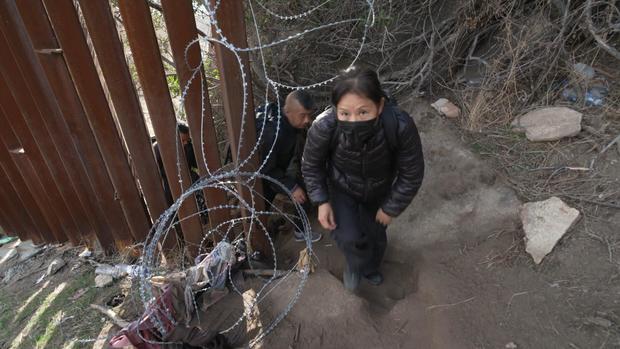
One point of entry is a 4-foot gap at the end of a border fence 60 miles east of San Diego. Smugglers in SUVs race along the border fence and drop migrants off near the gap. Over four days, "60 Minutes" witnessed nearly 600 migrants — adults and children — pass through the gap and onto U.S. soil, unchecked.
One man, a college graduate, said his trip from China took 40 days. He said he had traveled through Thailand, Morocco, Ecuador, Colombia, Panama, Costa Rica and Nicaragua on his way to the U.S border.
The gap is a global destination, littered with travel documents from around the world. With the help of a translator, "60 Minutes" met some of the Chinese migrants coming through, including a teacher, a banker, some small business owners and a factory worker.
Unlike the migrants who make the grueling journey through Central America, some middle class migrants from China arrive with rolling bags. Some said they took flights all the way to Mexico.
Many flew from China to Ecuador because it doesn't require a visa for Chinese nationals. Then they flew to Tijuana. The migrants said they connected with smugglers and paid $400 for the hour-long drive to the gap at the border.
The migrants knew about the hole because of TikTok. Posts on the app reviewed by "60 Minutes" featured step-by-step instructions for hiring smugglers and detailed directions to the border gap.
Once through the hole, the migrants walk about half a mile down a dusty road and wait in line for U.S. Border Patrol to arrive so they can surrender.
Why more Chinese migrants are turning to the U.S.-Mexico border
For years, millions of Chinese entered the U.S. with a visa that allowed them to visit, work or study. But in the last few years, those visas have been increasingly difficult to secure as tensions between the two countries have grown. In 2016, the U.S. granted 2.2 million temporary visas to Chinese nationals. Just 160,000 were granted in 2022.
With visas more difficult to acquire, many are turning to the U.S. southern border, where they cross illegally, then wait to be picked up by Border Patrol agents.
Jacqueline Arellano has used her Spanish skills in her eight years volunteering on the border , but lately, she's been relying on translation apps to communicate with Chinese migrants. Arellano believes it would be safer and more efficient for migrants to go to ports of entry.
At the legal points of entry, asylum-seekers can request an appointment to enter the U.S. through CBP One mobile app. The CBP One system is glitchy. Volunteers who work with migrants told us the wait is 3-4 months to secure an appointment with the app.
About two hours after "60 Minutes" watched migrants arrive through the border fence hole, Border Patrol pulled up and shared recorded instructions in Mandarin. The migrants were driven to a detention facility near San Diego. Once there, migrants get background checks and some are interviewed. Usually, they're released within 72 hours and can then begin the process of filing asylum claims.

Based on a "60 Minutes" review of Immigration and Customs Enforcement data, there are at least 36,000 Chinese who have been ordered by U.S. immigration courts to leave the country, but China often refuses to take back citizens and the U.S. can't force China to accept them.
Last year, 55% of Chinese migrants were granted asylum compared with 14% of migrants from other countries, according to the Department of Justice.
With the odds in their favor –and instructions on TikTok to guide them– there's little to discourage more Chinese migrants from coming through the gap, something that's made California resident Jerry Shuster's life very difficult.
"Nobody do nothing about it."
Shuster, a 75-year-old retiree, owns the land near the border gap where the migrants wait to be picked up by Border Patrol. He owns 17 acres just north of the border fence and a quarter mile outside of Jacumba Hot Springs , California. Shuster came to the U.S. from Yugoslavia. He describes his immigration journey as coming "through the front door."
"And I knock on this door," Shuster said. "I didn't bust the door down to come over here."
The surge of migrants onto his property has been a frustrating experience for him. He said authorities haven't done anything to help. "When they come over here, they come with the suitcases. They come prepared with the computers just like they got off on a Norwegian cruise ship yesterday," Shuster said.

Migrants began arriving on his property in May. He went to investigate some smoke coming from his property and found migrants burning trees to stay warm while they waited for Border Patrol to pick them up. Sometimes that can take a few hours. Other times, it takes days.
One day several months ago, he implored the migrants to stop burning his trees. He said they surrounded him –so he went home and got his gun. Shuster said he was arrested after he fired his gun into the air.
"I'm just protecting my own land," he said.
Shuster wasn't charged, but his gun was confiscated.
Since, Shuster estimates 3,000 migrants a week have come through the hole. Shuster's property is littered with the trash and tents migrants have left behind. He said officials know about the hole and that he's asked for it to be fixed.
"'You gotta call Washington D.C,' that's what they say," Shuster said.
U.S. Customs and Border Protection said their agents do not have authority to stop people from coming through gaps like the one by Shuster's home. Agents can only arrest the migrants after they enter illegally. As for closing the gap, the agency said it is on their priority list but would require money from Congress.
- Immigration
- Border Wall
- United States Border Patrol
- U.S.-Mexico Border

Sharyl Alfonsi is an award-winning correspondent for CBS News' 60 Minutes.
More from CBS News
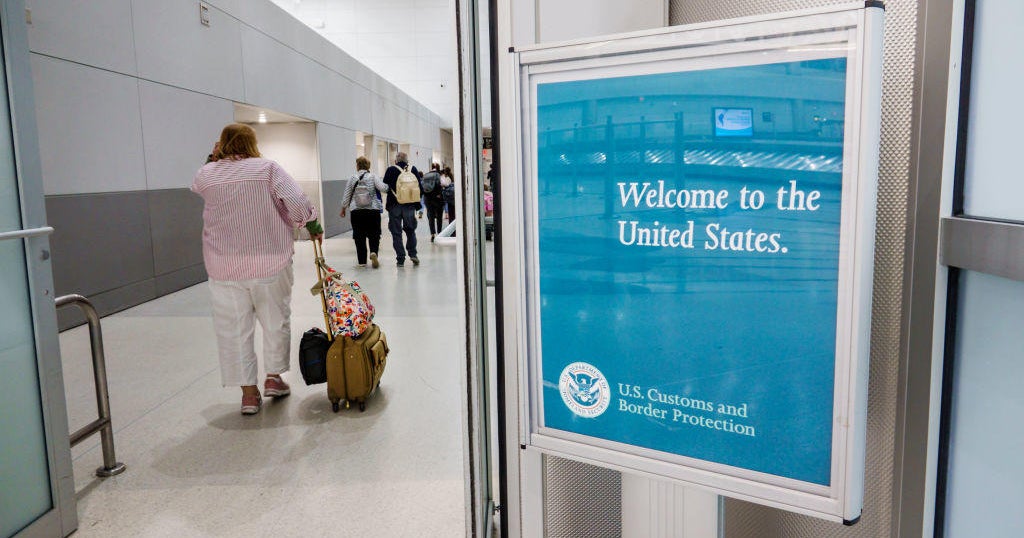
Senators renew scrutiny of border officers searching Americans' phones

Trial over jet fuel contamination in Hawaii's water set to begin

3 gold investing mistakes to avoid right now

The 3 most affordable borrowing options right now
Visa Traveler
Exploring the world one country at a time
Can you enter Mexico with US visa? – All your questions answered
Updated: October 30, 2023 6 Comments
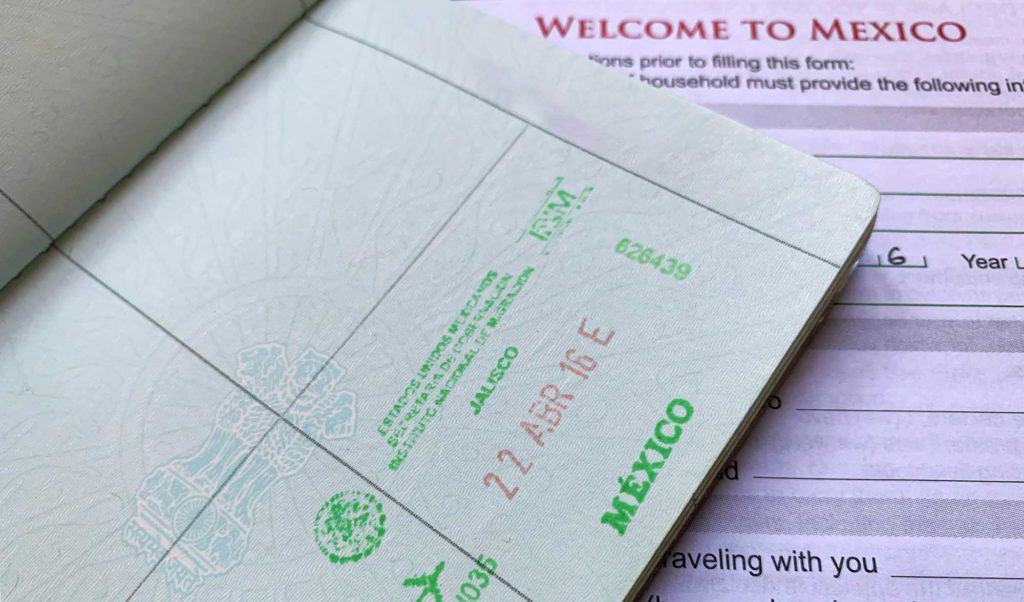
Mexico has a liberal visa policy allowing many nationalities to substitute Mexican visas with other country visas. The question often comes up: can you enter Mexico with US visa? The answer is a simple yes, but there are certain rules and requirements to keep in mind.
In this article, I’m going to answer all your questions about using a US visa to travel to Mexico.
Can you enter Mexico with US visa?
Yes. You can enter Mexico with US visa. Any nationality with a valid US visa can enter Mexico without requiring a Mexican visa. The US visa must be valid during the entire stay in Mexico. You can use any US visa including tourist, work, study and transit visas.
The airline staff and Mexican immigration officers are well aware of this visa requirement. There is no need to explain anything at check-in or immigration. Just present your passport and US visa.
Mexican immigration officers at land and seaports are also aware of these visa requirements, so entering Mexico with a US visa via land or seaports is a breeze too.
Traveling to Mexico with US visa
Mexico offers visa exemption to any nationality holding a valid US, UK, Canada, Schengen or Japan visa. Therefore, those that require a visa to Mexico can substitute a valid US visa for a Mexico visa.
I entered Mexico several times using my US B1/B2 and H1B visas, via popular airports like Mexico City and Cancun and also via the seaport at Chetumal.
The airport staff and immigration officials are very well aware of this requirement. So they don’t make a fuss about not holding a Mexican visa. They would check your passport for your US visa and then let you in.
If your US visa is valid but it’s in your old/expired passport, make sure to bring your old passport along with your new passport. Present both passports and tell the airline staff or immigration officer that your US visa is in your old passport.
Can I travel to Mexico with US B1/B2 visa?
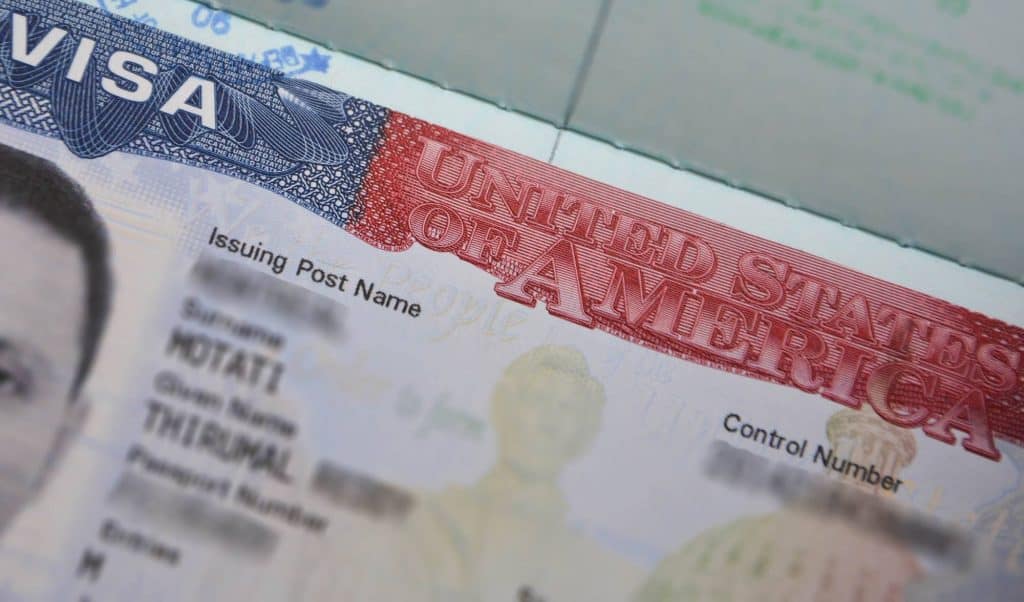
Yes. You can travel to Mexico with US B1/B2 visa . Any nationality with a valid US B1, B2 or B1/B2 visa can enter Mexico without requiring a Mexican visa.
Keep in mind that your US B1/B2 visa must be valid for the entire duration of your stay in Mexico.
Your US B1/B2 visa can be used or unused. Meaning, that if you have a fresh US visa and you haven’t used it to travel to the US yet, you can still use that US B1/B2 visa to enter Mexico.
All you have to do is to present your passport and valid US B1/B2 visa to the border officials.
PERSONAL EXPERIENCE I entered Mexico many times using my US B1/B2 visa via Mexico City airport and Chetumal seaport. I didn’t have to say that I plan to use my US B1/B2 visa. They flipped through the pages of my passport, found my US B1/B2 visa and stamped me in.
RELATED: 51 countries you can travel VISA-FREE with a US visa in 2023
Can I travel to Mexico with US H1B visa?
Yes. You can travel to Mexico with US H1B visa. Any nationality with a valid US H1, H2, H3 or H4 visa can enter Mexico without requiring a Mexican visa.
Your US H1B visa must be valid for your entire stay in Mexico. For example, if you plan to stay 1 month in Mexico, your H1B visa must be valid for at least 1 month at the time of entering Mexico.
If your H1B has already expired and you would like to travel to Mexico, then you would need to apply for a Mexico tourist visa .
That being said, if your H1B visa expires while you are in Mexico, you may not be able to return to the US.
If you stayed less than 30 days in Mexico and your US visa expired while you were in Mexico, you can still return to the US on your H1B using automatic revalidation . Since this article is about entering Mexico, I will not go deep into returning to the US.
PERSONAL EXPERIENCE I lived and worked in the US for over 8 years on an H1-B visa. I have traveled to Mexico many times using my US H1B visa. It’s super quick and easy to enter Mexico with a US H1-B visa. All border officials at the airports, seaports and land borders are aware of this US visa requirement, so you will not have any trouble using your US H1B to enter Mexico.
Can I enter Mexico with US F1 visa?
Yes. You can enter Mexico with US F1 visa. Any nationality with a valid US F1, F2, M1 or M2 visa can enter Mexico without requiring a Mexican visa.
Your F1 visa must be valid for your entire stay in Mexico. The airline staff and border officials are well aware of this requirement. They will treat all US visas alike and do not make a fuss about your US visa type or category.
If your US F1 visa is valid but is in an old/expired passport, you must bring your old passport along with the new passport. You must present both passports to the airline staff and border officials.
If your US F1 visa expires while you are in Mexico, you may not be able to get back to the US. But if you were in Mexico for less than 30 days, then you can return to the US using automatic revalidation even if your visa expired while you were in Mexico.
Can I visit Mexico with US L1 visa?
Yes, You can visit Mexico with US L1 visa. Any nationality with a valid US L1A, L1B or L2 visa can enter Mexico without requiring a Mexican visa.
Both L1 and L2 visas can be used to enter Mexico for tourism for up to 180 days. The Mexican border officials do not scrutinize the type of US visa. As long as your US visa is valid at the time of entering Mexico, you will be fine. But if your US L1 visa expires while you are in Mexico, you may not be able to get back to the US.
If your US L1 visa is valid but is in an old/expired passport, you must bring your old passport along with the new passport.
Can I enter Mexico with a US Green card?
Yes. You can enter Mexico with a US Green card . Any nationality with a valid US green card can enter Mexico without requiring a Mexican visa. Your US green card must be valid for the entire duration of your stay in Mexico.
US green card holders are pretty much treated like US passport holders for Mexican immigration. All you need is your passport and US green card.
RELATED: 40 countries you can travel VISA-FREE with a US Green Card in 2023
Can I enter Mexico with expired US visa?
No. You cannot enter Mexico with an expired US visa. The US visa must be valid at the time of entering Mexico and must be valid for the entire duration of the stay in Mexico.
If your visa expires after you enter Mexico, you may continue to stay for the allowed number of days. But you cannot return to the US.
If your US visa is valid but it’s in an expired passport, then you must carry both passports when you travel to Mexico.
Can I go to Cancun with US visa?
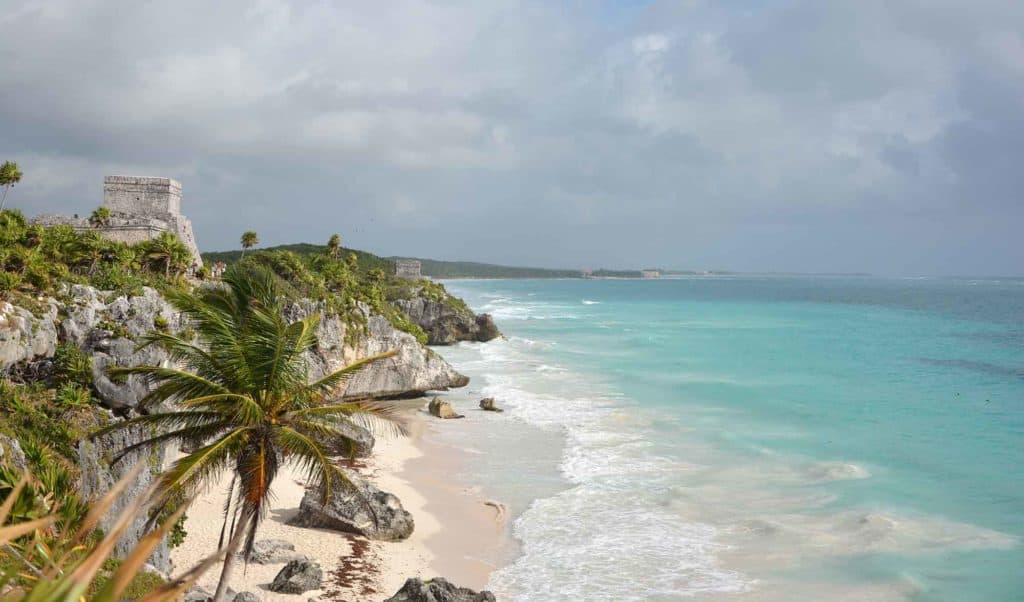
Yes. You can go to Cancun with US visa. Not only Cancun, but you can enter Mexico via any airport, seaport or land border using your US visa.
Cancun is a top tourist destination in Mexico. Hundreds of tourists who arrive at Cancun airport use their US visas to enter Mexico. All immigration officers at Cancun airport are aware of the US visa requirement. There is no need to explain anything. You just have to present your passport and valid US visa.
Can I enter Mexico with a one way ticket?
Yes. You can enter Mexico with a one-way ticket. But oftentimes, the Mexican border officials ask for proof of onward travel. It doesn’t have to be a flight ticket, it can be a bus or boat ticket out of Mexico.
It’s quite common for many to travel to Mexico on one-way tickets for the following reasons.
Many travelers leave for Belize by boat or to Guatemala by bus. Booking boat or bus tickets months in advance can be challenging.
Many travelers want to stay longer and decide their next destination later since Mexico grants 180-day entry.
Since there is a chance that immigration officers may ask for your return or onward ticket, it’s wise to have some proof of an onward ticket . If you can’t book a bus or boat ticket early, get proof of onward flight from any of those onward ticket agencies.
Do I have to enter the US first before going to Mexico?
No. You can fly into Mexico from anywhere as long as your US visa is valid.
This is a misconception that you have to enter the US first or enter Mexico from the US. All you need is a valid US visa. It doesn’t matter where you enter Mexico from.
I entered Mexico many times from the US, but I have also entered Mexico from various countries without even stepping into the US. The requirement is specifically about the US visa but has nothing to do with US travel itself. Therefore, you can enter Mexico from any country using your valid US visa.
Do I have to use my US visa first to enter the US before going to Mexico?
No. You don’t have to use your US visa to enter the US first. As long as the US visa is valid, you can enter Mexico without needing a Mexican visa.
Yes, there are a few countries that require you to use your US visa first to enter the US. But not Mexico. You can use your fresh and unused US visa to enter Mexico.
Can I travel to Mexico while in the US on a B1/B2 visa?
You can. But if you stay less than 30 days in Mexico and return to the US, then it won’t be considered a fresh entry.
As per the CBP, re-entering the US from contiguous countries such as Mexico or Canada does not constitute a fresh entry (new admission). This is to discourage travelers from doing visa runs for continuous stays in the US. Because of this, the re-entry process is also stringent. You may be asked quite a few questions when re-entering the US.
Let’s look at an example. When you enter the US, you will be granted 180 days of stay. Say, after 4 months, you leave for Mexico for a month and reenter the US, then you will only have 1 more month in the US. You will not be granted a fresh 6-month entry. You will have to leave within that 1 month.
Can I enter Mexico with Japan visa?
Yes. You can enter Mexico with a valid Japan visa. Any nationality with a valid Japan visa or Japan permanent residence card can enter Mexico without requiring a Mexican visa.
The Japan visa can be of any visa type but must be valid and affixed in your passport. If you are using your Japan residence visa or card, it must be a permanent residence card that would allow you to stay in Japan permanently.
Can I enter Mexico with Schengen visa?
Yes. You can enter Mexico with Schengen visa . Any nationality with a valid Schengen visa or a permanent residence permit in any Schengen country can enter Mexico without needing a Mexican visa.
The Schengen visa can be a short stay or a long stay, but it must be valid and affixed in the passport. If it’s a residence permit, then it must be a permanent residence permit that would allow you to reside in the Schengen area permanently.
RELATED: 51 non-Schengen countries you can visit VISA-FREE with a Schengen visa in 2023
Can I enter Mexico with a UK visa
Yes. You can enter Mexico with a UK visa . Any nationality with a valid UK visa or UK permanent residence permit can enter Mexico VISA-FREE.
Your UK visa can be a visitor, study, work or spouse visa but it must be valid and affixed in your passport. If you hold a residence permit it must be an ILR that would permit you to reside in the UK indefinitely.
RELATED: 40 countries you can travel VISA-FREE with a UK visa in 2023
Can I enter Mexico with a Canada visa
Yes. You can enter Mexico with a Canada visa . Any nationality with a valid Canada visa or Canada permanent residence card can enter Mexico VISA-FREE.
Your Canada visa can be a visitor, study or work visa but it must be valid and affixed in your passport. If you hold a residence permit it must be a permanent residence card that would permit you to reside in Canada permanently.
RELATED: 38 countries you can travel VISA-FREE with a Canada visa in 2023
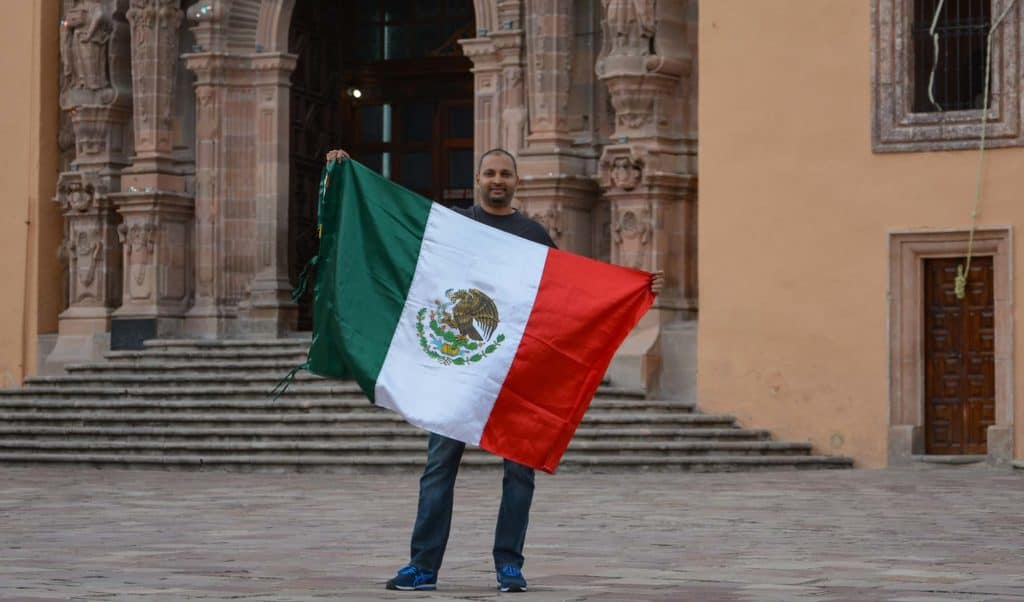
Can you travel to Mexico with a US visa? Yes. Any nationality with a valid US, UK, Canada, Schengen or Japan visa can enter Mexico VISA-FREE. The visa must be valid for the entire duration of the stay in Mexico.
There you go, guys! Everything you need to know about entering Mexico with a US visa.
Have you entered Mexico with a US visa? How was your experience? Let me know in the comments.
WRITTEN BY THIRUMAL MOTATI

Thirumal Motati is an expert in tourist visa matters. He has been traveling the world on tourist visas for more than a decade. With his expertise, he has obtained several tourist visas, including the most strenuous ones such as the US, UK, Canada, and Schengen, some of which were granted multiple times. He has also set foot inside US consulates on numerous occasions. Mr. Motati has uncovered the secrets to successful visa applications. His guidance has enabled countless individuals to obtain their visas and fulfill their travel dreams. His statements have been mentioned in publications like Yahoo, BBC, The Hindu, and Travel Zoo.
PLAN YOUR TRAVEL WITH VISA TRAVELER
I highly recommend using these websites to plan your trip. I use these websites myself to apply for my visas, book my flights and hotels and purchase my travel insurance.
01. Apply for your visa
Get a verifiable flight itinerary for your visa application from DummyTicket247 . DummyTicket247 is a flight search engine to search and book flight itineraries for visas instantly. These flight itineraries are guaranteed to be valid for 2 weeks and work for all visa applications.
02. Book your fight
Find the cheapest flight tickets using Skyscanner . Skyscanner includes all budget airlines and you are guaranteed to find the cheapest flight to your destination.
03. Book your hotel
Book your hotel from Booking.com . Booking.com has pretty much every hotel, hostel and guesthouse from every destination.
04. Get your onward ticket
If traveling on a one-way ticket, use BestOnwardTicket to get proof of onward ticket for just $12, valid for 48 hours.
05. Purchase your insurance
Purchase travel medical insurance for your trip from SafetyWing . Insurance from SafetyWing covers COVID-19 and also comes with a visa letter which you can use for your visas.
Need more? Check out my travel resources page for the best websites to plan your trip.
LEGAL DISCLAIMER We are not affiliated with immigration, embassies or governments of any country. The content in this article is for educational and general informational purposes only, and shall not be understood or construed as, visa, immigration or legal advice. Your use of information provided in this article is solely at your own risk and you expressly agree not to rely upon any information contained in this article as a substitute for professional visa or immigration advice. Under no circumstance shall be held liable or responsible for any errors or omissions in this article or for any damage you may suffer in respect to any actions taken or not taken based on any or all of the information in this article. Please refer to our full disclaimer for further information.
AFFILIATE DISCLOSURE This post may contain affiliate links, which means we may receive a commission, at no extra cost to you, if you make a purchase through a link. Please refer to our full disclosure for further information.
RELATED POSTS
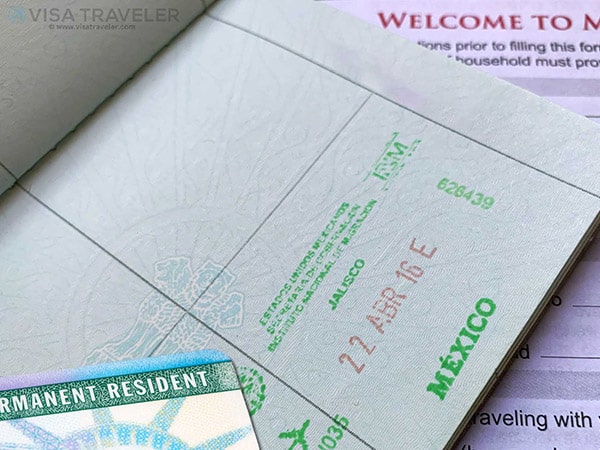
Loading 6 Comments... Please Wait.
- Cookie Policy
- Copyright Notice
- Privacy Policy
- Terms of Use
- Flight Itinerary
- Hotel Reservation
- Travel Insurance
- Onward Ticket
- Testimonials
Search this site

Surge of Chinese immigrants crossing border triggers national security concerns
T he number of Chinese citizens coming across the southern border from Mexico has skyrocketed to the fastest-growing demographic of illegal immigrants in recent months, triggering serious concerns among lawmakers in Washington.
Tens of thousands of Chinese immigrants have been arrested by Border Patrol agents over the past year, far beyond the hundreds to a couple of thousand seen in recent history preceding the COVID-19 pandemic, according to Customs and Border Protection data . In 2022, fewer than 2,000 Chinese people were stopped at the southern boundary.
In the first half of fiscal 2024 (from October 2023 to March 2024), Border Patrol agents on the U.S.-Mexico border caught 24,214 Chinese illegal immigrants who had come into the country by walking through unfenced areas. The figure is more than the record-high 24,048 Chinese immigrants arrested in all of 2023.
This year is on track to see 48,000 Chinese migrants arrested by the year's end if the current rate continues.
Federal lawmakers who work on national security matters are growing more worried about the threat it poses to Americans should China, a country viewed as an adversary of the United States, try to embed spies or other bad actors in the migrant population that has managed to escape China.
Rep. Tony Gonzales (R-TX), who represents a border district, asked Homeland Security Secretary Alejandro Mayorkas during a congressional hearing last week about the surge.
"The increase in Chinese nationals that we see — the numbers are astronomical, especially in California and some of those areas," Gonzales said during a House Homeland Security Committee hearing on April 16.
Of the 24,214 Chinese migrants interdicted at the 2,000-mile southern border over the past six months, 95% of arrests occurred in Southern California's San Diego region.
Mayorkas said he shared Gonzales's concern and was looking at ways to get China to accept its deported citizens back. At present, China will not allow the U.S. to return Chinese citizens who have fled the country.
In February, House Select Committee on the Chinese Communist Party Chairman Mike Gallagher (R-WI) called for the social media app TikTok to be sold to a U.S. company or be banned because of how smugglers were using the app to facilitate human smuggling from China. The House last week passed legislation to force the sale of TikTok, and the Senate is poised to do the same as soon as Tuesday.
"Under the Biden administration’s policies, reports demonstrate that migrants receive step-by-step instructions from CCP-controlled TikTok on where to illegally cross into the United States," Gallagher, who was set to retire from Congress following his vote on the TikTok bill Saturday, said at the time.
Thus far, in 2024, more than 1 million illegal immigrants have been arrested across the southern border from more than 150 countries. Last year, more than 2 million illegal immigrants were apprehended.

- Cancun Tourism
- Cancun Hotels
- Cancun Bed and Breakfast
- Cancun Vacation Rentals
- Flights to Cancun
- Cancun Restaurants
- Things to Do in Cancun
- Cancun Travel Forum
- Cancun Photos
- All Cancun Hotels
- Cancun Hotel Deals
- Last Minute Hotels in Cancun
- Things to Do
- Restaurants
- Vacation Rentals
- Travel Stories
- Rental Cars
- Add a Place
- Travel Forum
- Travelers' Choice
- Help Center
Wife green card w/Chinese passport - Cancun Forum
- Mexico
- Yucatan Peninsula
- Quintana Roo
- Cancun
Wife green card w/Chinese passport

- United States Forums
- Europe Forums
- Canada Forums
- Asia Forums
- Central America Forums
- Africa Forums
- Caribbean Forums
- Mexico Forums
- South Pacific Forums
- South America Forums
- Middle East Forums
- Honeymoons and Romance
- Business Travel
- Train Travel
- Traveling With Disabilities
- Tripadvisor Support
- Solo Travel
- Bargain Travel
- Timeshares / Vacation Rentals
- Quintana Roo forums
- Cancun forum

My wife has a Chinese passport and a US green card. I have been told this is enough to get into Mexico by the consulate here in the US. Do we need to bring documentation of this with us?

I would contact a Mexican embassy or similar and hope that they provide accurate information.
I would try to get something IN WRITING from the Mexican consulate or embassy. See this thread - https://www.tripadvisor.ca/ShowTopic-g150807-i8-k9299146-Rejected_to_get_into_Mexico_need_help-Cancun_Yucatan_Peninsula.html
Yes I saw that. Hence why I was asking if there was something in writing somewhere on the internet.
Ok, from the consulate in San Francisco:
General Information:
Effective March 1st 2010, all US Citizens are required to present U. S. Passport or U.S. Passport Card when entering Mexico (traveling by air, land or sea).
US Permanent Residents traveling by air, land or sea to Mexico are required to present a valid Permanent Resident Card. Plus a valid and not expired passport or travel document. If you do not have that card consult other documentation also accepted to prove the US Permanent Residence status (Link).
Other nationalities, Non-US Permanent Residents. Starting May 1st, 2010, all those foreign nationals, regardless of their nationality, visiting Mexico for tourist, business or transit matters won't need a Mexican visa as long as they have with them a valid and not expired USA visa in the passport. In this context, if you have a valid US visa in the passport you do not need to obtain a Mexican visa.
If the US visa stamped in your passport already expired but you have an official document or form proving your legal status in USA, you should apply for a Mexican visa at this Consulate (I-797 A Forms, Advance Parole Forms, I-20 OR DS-2019 Forms won’t be good enough for entering to Mexico). No appointment is required to apply for Visa. Applicants should apply in person Monday-Friday 9:00 am to 1:00 pm. Further questions email: [email protected] Diplomatic and Official visas. Contact the Visas Department at the Mexican Consulate.
Temporary Import Permit for Equipment.
Household Inventory Permit.
That second one there: " US Permanent Residents traveling by air, land or sea to Mexico are required to present a valid Permanent Resident Card. Plus a valid and not expired passport or travel document. If you do not have that card consult other documentation also accepted to prove the US Permanent Residence status" I guess that covers it

Here is a link to the Mexican consulate web site with information:
http://consulmex.sre.gob.mx/washington/index.php/en/component/content/article/182
Based on this from the web site, I think you are in the clear:
"United States citizens and foreigners who are permanent residents (green card holders) or with a valid visa stamped on their passports, do not require a visa to travel to Mexico on tourism or non paid activities and stay up to 180 days."
If you are a permanent resident of the USA with your green card, you can enter Mexico as a tourist without a visa regardless of your nationality.
This topic has been closed to new posts due to inactivity.
- Is Cancun airport always so terrible? 11:51 am
- Best way from airport to hotel zone. 11:23 am
- Taxi driver arrested for charging Canadian tourist $1000 USD 10:53 am
- Getting around Cancun 10:49 am
- Father & daughter trip to Cancun - where and when ? 9:06 am
- American Airlines baggage 8:57 am
- Puerto Madero in Cancun 8:30 am
- Tipping in an all inclusive resort 8:00 am
- AQUA Experiences Cancun - Private Yacht Rental yesterday
- RIU (U) Room Reservation yesterday
- Is there a pain-free way of hiring a car in Cancun? yesterday
- Girl's Trip- Budget Friendly Luxury? yesterday
- Is me yesterday
- Getting to Puerto Morelos for the day from hotel zone Apr 25, 2024
- THE best all inclusive ?? 16 replies
- Secrets The Vine Cancun 254 replies
- Best Time of Year to Visit Cancun...?? 14 replies
- New RIU Palace Peninsula 469 replies
- Party resorts for 20-30 years old? 26 replies
- December weather? 11 replies
- cancun airport transfers 11 replies
- Best time of the year to go Mexico?? 18 replies
- How is the weather in Cancun in August? 7 replies
- Best All Adult Singles All Inclusive Resorts in Cancun? 19 replies
Cancun Hotels and Places to Stay
- Safety, Advice, Tips, and Hurricanes -
- Maps of Area Resorts
- Cancun Restaurant Trip Advisor Listing and Ratings
- Dollars or Pesos: What should I use?
- Weather: What will it be like in ...
- Bus, Taxi or Private Driver: Getting around Cancun
- Private/public ground transfer options:
- Online Tourist Card
- Airport Arrival, immigration limits,and hotel tranportation
- Best way to get to Isla and what to do
- Replacing a lost immigration form (tourist card)
- Avoid immigration jail. Verify your FMM visit duration.
- AA Meetings in Cancun and Nearby
- Departure Tax: Do I have to pay to leave Cancun?
- Travelling to Cancun/Riviera Maya with a criminal record
- WEATHER & June thru November - Hurricane Season Information
- How Do I Go by Bus from Cancun to Merida

Numbers, Facts and Trends Shaping Your World
Read our research on:
Full Topic List
Regions & Countries
- Publications
- Our Methods
- Short Reads
- Tools & Resources
Read Our Research On:
What we know about unauthorized immigrants living in the U.S.
The unauthorized immigrant population in the United States reached 10.5 million in 2021, according to new Pew Research Center estimates. That was a modest increase over 2019 but nearly identical to 2017.
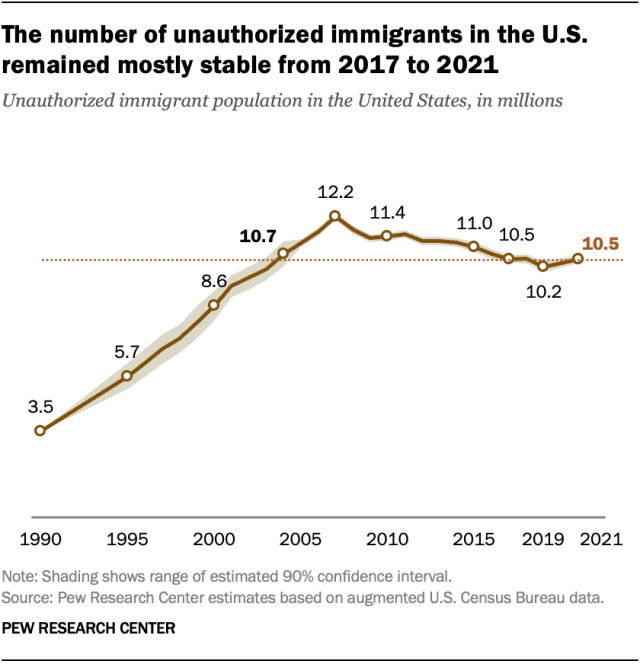
The number of unauthorized immigrants living in the U.S. in 2021 remained below its peak of 12.2 million in 2007. It was about the same size as in 2004 and lower than every year from 2005 to 2015.
The new estimates do not reflect changes that have occurred since apprehensions and expulsions of migrants along the U.S.-Mexico border started increasing in March 2021 . Migrant encounters at the border have since reached historic highs .
Pew Research Center undertook this research to understand ongoing changes in the size and characteristics of the unauthorized immigrant population in the United States. The Center has published estimates of the U.S. unauthorized immigrant population for more than two decades. The estimates presented in this research are the Center’s latest, adding new and updated annual estimates for 2017 through 2021.
Center estimates of the unauthorized immigrant population use a “residual method.” It is similar to methods used by the U.S. Department of Homeland Security’s Office of Immigration Statistics and nongovernmental organizations, including the Center for Migration Studies and the Migration Policy Institute . Those organizations’ estimates are generally consistent with ours. Our estimates also align with official U.S. data sources, including birth records, school enrollment figures and tax data, as well as Mexican censuses and surveys.
Our “residual” method for estimating the nation’s unauthorized immigrant population includes these steps:
- Estimate the total number of immigrants living in the country in a particular year using data from U.S. censuses and government surveys such as the American Community Survey and the Current Population Survey.
- Estimate the number of immigrants living in the U.S. legally using official counts of immigrant and refugee admissions together with other demographic data (for example, death and out-migration rates).
- Subtract our estimate of lawful immigrants from our estimate of the total immigrant population . This provides an initial estimate of the unauthorized immigrant population .
Our final estimate of the U.S. unauthorized immigrant population, as well as estimates for lawful immigrants, includes an upward adjustment. We do this because censuses and surveys tend to miss some people . Undercounts for immigrants, especially unauthorized immigrants, tend to be higher than for other groups. (Our 1990 estimate comes from work by Robert Warren and John Robert Warren; details can be found here .)
The term “unauthorized immigrant” reflects standard and customary usage by many academic researchers and policy analysts. The U.S. Department of Homeland Security’s Office of Immigration Statistics also generally uses it. The term means the same thing as undocumented immigrants, illegal immigrants and illegal aliens.
For more details on how we produced our estimates, read the Methodology section of our November 2018 report on unauthorized immigrants.
The unauthorized immigrant population includes any immigrants not in the following groups:
- Immigrants admitted for lawful residence (i.e., green card admissions)
- People admitted formally as refugees
- People granted asylum
- Former unauthorized immigrants granted legal residence under the 1985 Immigration Reform and Control Act
- Immigrants admitted under any of categories 1-4 who have become naturalized U.S. citizens
- Individuals admitted as lawful temporary residents under specific visa categories
Read the Methodology section of our November 2018 report on unauthorized immigrants for more details.
Pew Research Center’s estimate of unauthorized immigrants includes more than 2 million immigrants who have temporary permission to be in the United States. (Some also have permission to work in the country.) These immigrants account for about 20% of our national estimate of 10.5 million unauthorized immigrants for 2021.
Although these immigrants have permission to be in the country, they could be subject to deportation if government policy changes. Other organizations and the federal government also include these immigrants in their estimates of the U.S. unauthorized immigrant population.
Immigrants can receive temporary permission to be in the U.S. through the following ways:
Temporary Protected Status (TPS)
In 2021, there were about 500,000 unauthorized immigrants with Temporary Protected Status . This status provides protection from removal or deportation to individuals who cannot safely return to their country because of civil unrest, violence or natural disaster.
Deferred Enforced Departure (DED) is a similar program that grants protection from removal. The number of immigrants with DED is much smaller than the number with TPS.
Deferred Action for Childhood Arrivals (DACA)
Deferred Action for Childhood Arrivals is a program that offers protection from deportation to individuals who were brought to the U.S. as children before June 15, 2007. As of the end of 2021, there were slightly more than 600,000 DACA beneficiaries , largely immigrants from Mexico.
Asylum applicants
Individuals who have applied for asylum but are awaiting a ruling are not legal residents yet but cannot be deported. There are two types of asylum claims, defensive and affirmative .
Defensive asylum applications are generally filed by individuals facing deportation or removal from the U.S. These are processed by the Department of Justice’s Executive Office for Immigration Review. At the end of 2021, there were almost 600,000 applications pending.
Affirmative asylum claims are made by individuals already in the U.S. who are not in the process of being deported or removed. These claims are handled by the U.S. Department of Homeland Security’s Citizenship and Immigration Services (USCIS). At the end of 2021, more than 400,000 applications for affirmative asylum were pending, some covering more than one applicant.
Here are key findings about how the U.S. unauthorized immigrant population changed from 2017 to 2021:
- The most common country of birth for unauthorized immigrants is Mexico. However, the population of unauthorized immigrants from Mexico dropped by 900,000 from 2017 to 2021 , to 4.1 million.
- There were increases in unauthorized immigrants from nearly every other region of the world – Central America, the Caribbean, South America, Asia, Europe and sub-Saharan Africa.
- Among U.S. states, only Florida and Washington saw increases to their unauthorized immigrant populations , while California and Nevada saw decreases. In all other states, unauthorized immigrant populations were unchanged.
- 4.6% of U.S. workers in 2021 were unauthorized immigrants , virtually identical to the share in 2017.
Trends in the U.S. immigrant population
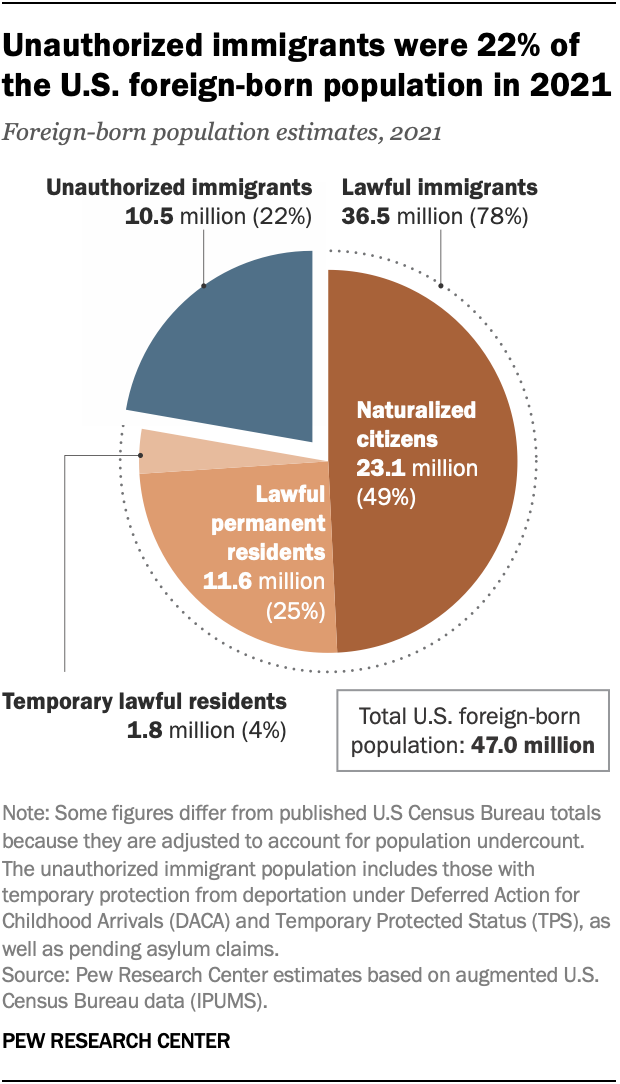
The U.S. foreign-born population was 14.1% of the nation’s population in 2021. That was very slightly higher than in the last five years but below the record high of 14.8% in 1890.
As of 2021, the nation’s 10.5 million unauthorized immigrants represented about 3% of the total U.S. population and 22% of the foreign-born population. These shares were among the lowest since the 1990s.
Between 2007 and 2021, the unauthorized immigrant population decreased by 1.75 million, or 14%.
Meanwhile, the lawful immigrant population grew by more than 8 million, a 29% increase, and the number of naturalized U.S. citizens grew by 49%. In 2021, naturalized citizens accounted for about half (49%) of all immigrants in the country.
Where unauthorized immigrants come from
Unauthorized immigrants living in the U.S. come from many parts of the world, with Mexico being the most common origin country.
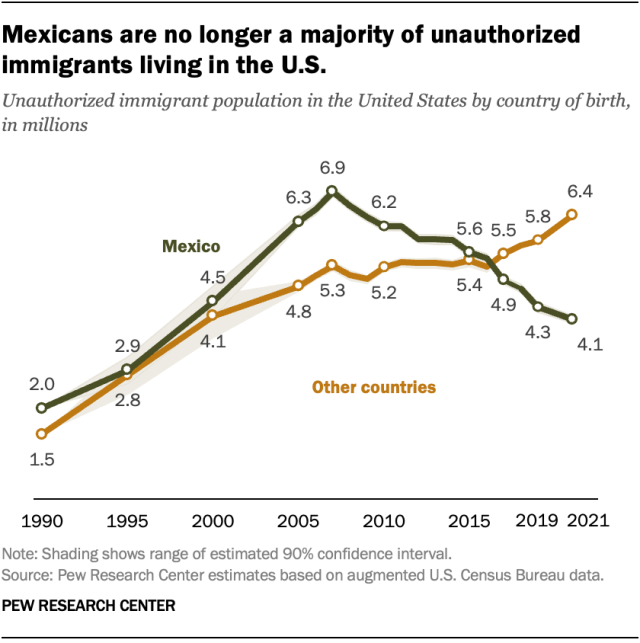
The origin countries for unauthorized immigrants have changed since the population peaked in 2007, before the Great Recession slowed immigration. Here are some highlights of those changes:
The number of unauthorized immigrants from Mexico living in the U.S. (4.1 million in 2021) was the lowest since the 1990s. Mexico accounted for 39% of the nation’s unauthorized immigrants in 2021, by far the smallest share on record .
The decrease in unauthorized immigrants from Mexico reflects several factors:
- A broader decline in migration from Mexico to the U.S.
- Mexican immigrants to the U.S. continuing to return to Mexico
- Expanded opportunities for lawful immigration from Mexico and other countries, especially for temporary agricultural workers.
The rest of the world
The total number of unauthorized immigrants in the U.S. from countries other than Mexico has grown rapidly. In 2021, this population was 6.4 million, up by 900,000 from 2017.
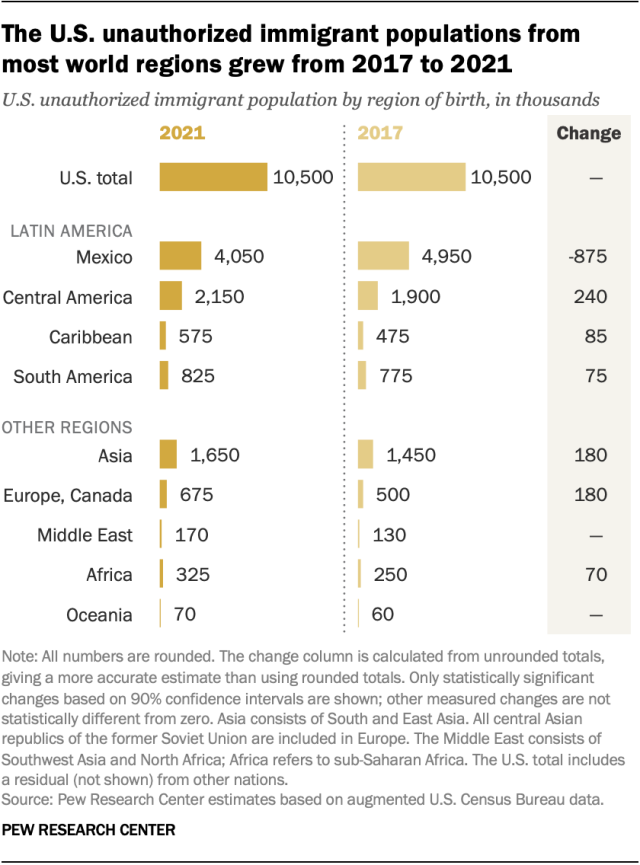
Almost every region in the world had a notable increase in the number of unauthorized immigrants in the U.S. from 2007 to 2021. The largest increases were from Central America (240,000) and South and East Asia (180,000).
After Mexico, the countries of origin with the largest unauthorized immigrant populations in the U.S. in 2021 were:
- El Salvador (800,000)
- India (725,000)
- Guatemala (700,000)
- Honduras (525,000)
India, Guatemala and Honduras all saw increases from 2017.
The Northern Triangle
Three Central American countries – El Salvador, Honduras and Guatemala – together represented 2.0 million unauthorized immigrants in the U.S. in 2021, or almost 20% of the total. The unauthorized immigrant population from the Northern Triangle grew by about 250,000 from 2017 and about 700,000 from 2007.
Other origin countries
Venezuela was the country of birth for 190,000 U.S. unauthorized immigrants in 2021. This population saw particularly fast growth, from 130,000 in 2017 and 55,000 in 2007.
Among countries with the largest numbers of U.S. unauthorized immigrants, India, Brazil, Canada and former Soviet Union countries all experienced growth from 2017 to 2021.
Some origin countries with significant unauthorized immigrant populations showed no change, notably China (375,000) and the Dominican Republic (230,000).
Detailed table: Unauthorized immigrant population by region and selected country of birth (and margins of error), 1990-2021 (Excel)
U.S. states of residence of unauthorized immigrants
The unauthorized immigrant population in most U.S. states stayed steady from 2017 to 2021. However, four states saw significant changes:
- Florida (+80,000)
- Washington (+60,000)
- California (-150,000)
- Nevada (-25,000)
States with the most unauthorized immigrants
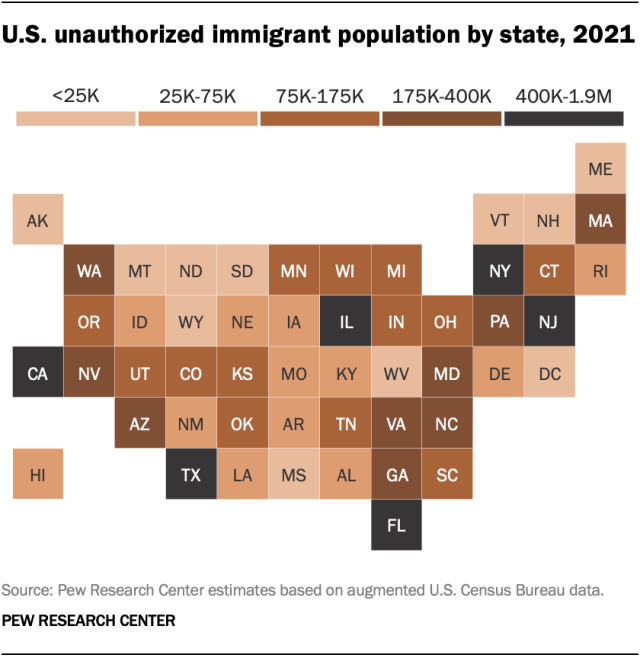
The six states with the largest unauthorized immigrant populations in 2021 were:
- California (1.9 million)
- Texas (1.6 million)
- Florida (900,000)
- New York (600,000)
- New Jersey (450,000)
- Illinois (400,000)
These states have consistently had the most unauthorized immigrants since 1990 and earlier .
At the same time, the unauthorized immigrant population has become less geographically concentrated. In 2021, these six states were home to 56% of the nation’s unauthorized immigrants, down from 80% in 1990.
Detailed table: Unauthorized immigrant population for states (and margins of error), 1990-2021 (Excel)
Detailed table: Unauthorized immigrants and characteristics for states, 2021 (Excel)
Unauthorized immigrants in the labor force
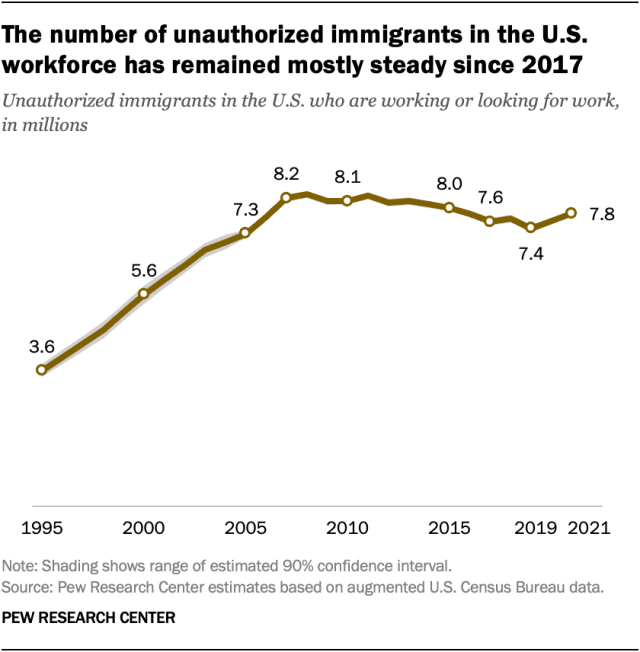
The share of unauthorized immigrants in the U.S. workforce was slightly less than 5% in 2021, compared with 3% of the total U.S. population.
Demographics help explain the difference: The unauthorized immigrant population includes relatively few children or elderly adults, groups that tend not to be in the labor force.
Overall, about 7.8 million unauthorized immigrants were in the U.S. labor force in 2021. That was up slightly from 2019 but smaller than every year from 2007 through 2015.
Detailed table: Unauthorized immigrants in the labor force for states, 2021 (Excel)
Here are some additional findings about unauthorized immigrants as a share of the workforce nationwide and in certain states:
- Since 2003, unauthorized immigrants have made up 4.4% to 5.4% of all U.S. workers, a relatively narrow range.
- Fewer than 1% of workers in Maine, Montana, Vermont and West Virginia in 2021 were unauthorized immigrants.
- Nevada (9%) and Texas (8%) had the highest shares of unauthorized immigrants in the workforce.
- Immigrant Populations
- Immigration Issues
- Unauthorized Immigration

Jeffrey S. Passel is a senior demographer at Pew Research Center

Jens Manuel Krogstad is a senior writer and editor at Pew Research Center
Key facts about Asian Americans living in poverty
Latinos’ views on the migrant situation at the u.s.-mexico border, key facts about the nation’s 47.9 million black americans, key facts about the wealth of immigrant households during the covid-19 pandemic, 8 facts about recent latino immigrants to the u.s., most popular.
1615 L St. NW, Suite 800 Washington, DC 20036 USA (+1) 202-419-4300 | Main (+1) 202-857-8562 | Fax (+1) 202-419-4372 | Media Inquiries
Research Topics
- Age & Generations
- Coronavirus (COVID-19)
- Economy & Work
- Family & Relationships
- Gender & LGBTQ
- Immigration & Migration
- International Affairs
- Internet & Technology
- Methodological Research
- News Habits & Media
- Non-U.S. Governments
- Other Topics
- Politics & Policy
- Race & Ethnicity
- Email Newsletters
ABOUT PEW RESEARCH CENTER Pew Research Center is a nonpartisan fact tank that informs the public about the issues, attitudes and trends shaping the world. It conducts public opinion polling, demographic research, media content analysis and other empirical social science research. Pew Research Center does not take policy positions. It is a subsidiary of The Pew Charitable Trusts .
Copyright 2024 Pew Research Center
Terms & Conditions
Privacy Policy
Cookie Settings
Reprints, Permissions & Use Policy

IMAGES
VIDEO
COMMENTS
Mexico Business Visa: Chinese nationals can use this visa to participate in various business activities, including trade exhibitions, seminars, conferences, and meetings. Mexico Work Visa: Holders of this visa are eligible to work in Mexico if they have received a job offer or employment agreement from a Mexican-based business as a Chinese citizen.
All foreign citizens must hold a valid and eligible passport if they wish to enter the Mexican territory. For all visitors, the passport must: Be valid for at least 6 months after the intended date of entry. Contain blank pages to receive entry/exit stamps. Travelers crossing into Mexico by land are able to use either a valid passport book or ...
Chinese citizens must obtain a visa before travelling to Mexico. Mexico Tourist visa is required for Chinese citizens. Mexico tourist visa is also know as Mexico Visitor visa. With this tourist visa stay is usually short with a period of 30 days and visa expires in 90 days. Applicant is required to be present when applying for Mexico tourist visa. A total of 10 documents are required for ...
China, since reopening its borders in 2023 after three years of self-imposed isolation due to COVID-19, has sealed visa waiver pacts with select countries to encourage travel of its citizens, a ...
1. Re: Chinese Citizen/US Resident Traveling to Mexico. 6 years ago. Maybe check with the Mexican Consulate. I think if you have a visa to the U.S. you can go to Mexico, but not sure how that all wraps up with a green card. Report inappropriate content. jordansbulls.
Learn more before traveling to Mexico in 2024: do Chinese citizens need a travel visa, is it safe to travel to Mexico right now. Skip to main content ... (out of 5). We highly recommend to reconsider your need to travel to Mexico. The safety index is based on travel advisories from independent 7 sources. Safety index is provided by www.travel ...
Yes, Chinese citizens can visit Mexico. However, they need to obtain a visa for tourism before visiting the country. Mexico does not have visa exemptions for Chinese passport holders. ... Can Chinese citizens travel freely? Chinese citizens have limited travel freedom. The Chinese passport is currently ranked 72nd by the Henley Passport Index ...
"Traveling from China to Mexico Made Easy in 2023: Visa Requirements, Travel Tips, and Popular Destinations"
This can include proof of accommodation, travel itinerary, sufficient funds, and medical and travel insurance, among other things. It's essential to check the specific requirements before traveling to México to avoid any issues at customs. ... To obtain a work visa in Mexico, Chinese citizens must meet certain requirements, which can vary ...
Visitors requiring a visa. Chinese, Indian, Russian and South African citizens are among those who are required to have a tourist visa to enter Mexico.In addition to having a valid passport, the following must be submitted in person at the nearest Mexican embassy or consulate:. Visa application form
This article will tell you everything you should be aware of when getting a visa application to travel to Mexico as a citizen from China. Read Also About: Mauritius. Read Also About: Mauritania. About Mexico. Mexico is one of the most beautiful nations in the world. It is famous for its diverse culture and rich heritage.
Mexico tourist visa exemptions (up to 180 days) If you have a regular passport issued by one of the following countries, you do not need a visa to visit Mexico for tourism or business purposes for up to 180 days. You may also transit in Mexico without a visa for up to 30 days.>. Everyone who is travelling to Mexico for tourism, visit, business ...
Chinese citizens who wish to travel to Mexico for leisure or business purposes no longer need to apply for a visa in advance. Instead, they can now apply for a Chinese Green Card, which will allow them to stay in Mexico for up to 90 days. The process of applying for a Chinese Green Card is relatively simple. First, Chinese citizens must fill ...
Call us in Washington, D.C. at 1-888-407-4747 (toll-free in the United States and Canada) or 1-202-501-4444 (from all other countries) from 8:00 a.m. to 8:00 p.m., Eastern Standard Time, Monday through Friday (except U.S. federal holidays). See the State Department's travel website for the Worldwide Caution and Travel Advisories.
Chinese immigration to Mexico began during the colonial era and has continued to the present day. However, the largest number of migrants to Mexico have arrived during two waves: the first spanning from the 1880s to the 1940s and another, reinvigorated wave of migrants arriving since the early 21st century. Between 1880 and 1910, during the term of President Porfirio Díaz, the Mexican ...
Last year, U.S. Customs and Border Protection reported 37,000 Chinese citizens were apprehended as they illegally crossed the border; that's 50 times more than two years earlier.
The Chinese passport ranks 118th in the world as of April 2024 according to VisaGuide Passport Index. This means that Chinese citizens can travel visa-free to 49 countries in the world. However, to enter the remaining countries, Chinese passport holders must apply for a visa beforehand.
An ordinary Chinese passport. Visa requirements for Chinese citizens are administrative entry restrictions imposed on citizens of China by the authorities of other states.. As of 2024, Chinese citizens had visa-free or visa on arrival access to 88 countries and territories, ranking the Chinese passport 63rd in the world according to the Henley Passport Index.
Citizens from the following countries who wish to visit Mexico as tourists, in transit, for business, technical activities, ... Visitors who travel on cruise ships that disembark at any Mexican port to visit the port and surrounding zones and embark on the same ship to continue their voyage, do not require a visa and will have collective ...
Yes. You can travel to Mexico with US B1/B2 visa. Any nationality with a valid US B1, B2 or B1/B2 visa can enter Mexico without requiring a Mexican visa. Keep in mind that your US B1/B2 visa must be valid for the entire duration of your stay in Mexico. Your US B1/B2 visa can be used or unused.
Mexico. Mexican citizens must obtain a visa before travelling to China. China Tourist visa is required for Mexican citizens. China tourist visa is also know as China L Visa. With this tourist visa stay is usually short with a period of 30 days and visa expires in 90 days. Applicant is not required to be present when applying for China tourist visa.
The number of Chinese citizens coming across the southern border from Mexico has skyrocketed to the fastest-growing demographic of illegal immigrants in recent months, triggering serious concerns ...
Mexican citizens must obtain a visa before entry into China. Reach China embassy or consulate for the instructions how to apply the visa. Updated: 04/23/2024. Entry requirements. visa required.
10 reviews. 2 helpful votes. 4. Re: Wife green card w/Chinese passport. 8 years ago. Save. Ok, from the consulate in San Francisco: General Information: Effective March 1st 2010, all US Citizens are required to present U. S. Passport or U.S. Passport Card when entering Mexico (traveling by air, land or sea).
Immigrants admitted under any of categories 1-4 who have become naturalized U.S. citizens; ... common country of birth for unauthorized immigrants is Mexico. However, the population of unauthorized immigrants from Mexico dropped by 900,000 from 2017 to 2021, to 4.1 million. ... notably China (375,000) and the Dominican Republic (230,000). ...